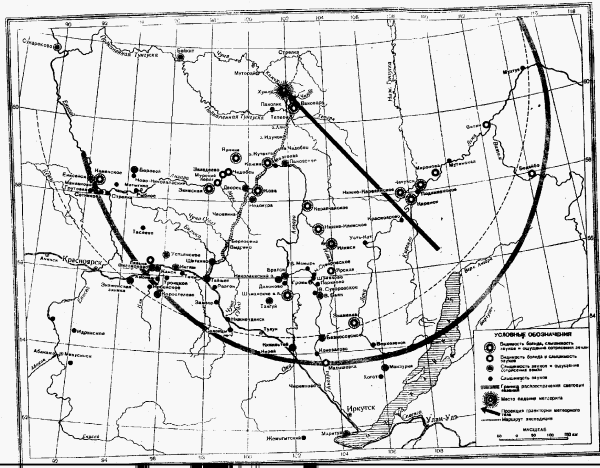
You are at the A. Ol'khovatov web-page: www.tunguska.eu5.org/tunguska.htm
Please pay attention that more detailed info on Tunguska can be found in my papers, for example through my ORCID
https://orcid.org/0000-0002-6043-9205
The last update: March 3, 2021
-----------------------------------
Dedicated to the memory of my dear mother, who died on February 6, 2020, without the multifaceted support of whom my research and this web-page would hardly have appeared...
-----------------------------------
Go to the A. Ol'khovatov Web-site directory in English:
www.tunguska.eu5.org
(but most of my web-site is still here: www.olkhov.narod.ru/tunguska/index.html )
ANNOTATION
Here the author's idea (first it was published in IZVESTIA ACADEMY
OF SCIENCES OF USSR in 1991, and now it is already rather popular among
Tunguska researchers) is explained that the famous 1908 Tunguska event
in Siberia was not an impact of a stony asteroid/meteorite or a comet, but a
manifestation of geophysical (terrestrial) processes: roughly speaking, a
result of coupling between tectonic and atmospheric processes in very rare
combination of favourable geophysical factors.
In general it is based on the following:
Simultaneous realization of all these geophysical phenomena together
with Tunguska as just pure accidental coincidence is very unlikely.
Remarkably, that on small scales similar geophysical micro-Tunguskas
occur rather often.
The exact physical mechanism of Tunguska event is still disputable.
In my opinion electromagnetic phenomena play large role in it.
Here is a note from SCIENCE magazine - a reaction on the above-mentioned discussion of Tunguska at the Brunel Univ. conference (SCIENCE's issue of Sept.13, 2002, p.1803):
On the morning of 30 June, 1908, in the remote Tunguska forest of Siberia,
a vast explosion charred and flattened trees across an area nearly as large
as Rhode Island.
Scientists have been mystified for years over the cause, although
prevailing wisdom has it that an extra-terrestrial chunk of ice or rock
struck Tunguska (Science, 20 August 1999, p. 1205).
At a conference in London last week on environmental
catastrophes, physicists from Russia and Germany rejected the 'ET
hypothesis.' Andrei Ol'khovatov, formerly of the Soviet Radio Instrument
Industry Research Institute, noted that decades of research has failed to
find definitive traces of extraterrestrial material. No impact crater has
been found and, more tellingly, patches of trees were left untouched near
the epicenter of the blast.
Wolfgang Kundt, an astrophysicist from Bonn University, Germany,
then proposed an alternative scenario: a massive gas explosion. A large
natural gas deposit lies below the site, a well-known fact unconnected to
the event until now, he said. Kundt has modeled a Tunguska 'outgassing' and
says it would fit with eyewitness accounts of the event.
"The geophysical hypothesis is a fresh idea," says Jesus Martinez-Frias of
the National Aerospace Institute in Madrid, Spain "It could be the answer."
But Ol'khovatov believes Tunguska was a "poorly understood strong coupling
between subterranean and meteorological phenomena" that science is not yet
ready to understand.
Please pay attention that this article (below) was first written for internet in 1996 and since that times is updated from time to time. So it a bit sketchy as I don't have time to re-write it completely.
My scientific publications on the matter can be found via my ORCID
1. INTRODUCTION
2. THE PROBLEMS OF THE METEORITE FALL INTERPRETATION
2.1. THE EYEWITNESSES ACCOUNTS
2.2. THE FOREST FALL
2.3. THE TREES BURN
2.4. THE SEISMIC PHENOMENA, CHELYABINSK-2013 (briefly) AND PRECURSORS
2.5. THE CHEMICAL TRACES
2.6. THE BIOLOGICAL CONSEQUENCES
2.7. THE SKY GLOW
2.8. COMPARASION WITH THE 2013 CHELYABINSK METEORITE
3. THE TECTONIC INTERPRETATION
3.1. LUMINOUS EFFECTS OF TECTONIC ACTIVITY
3.2. MAIN FEATURES OF GEOMETEORS
3.3. EXAMPLES OF GEOMETEORS
3.4. THE TECTONIC AND METEOROLOGICAL ACTIVITY AT THE
SITE AND THE TIME OF THE TUNGUSKA
3.5. THE PROPOSED SCENARIO OF THE TUNGUSKA
3.6. THE EYEWITNESSES ACCOUNTS
3.7. THE FOREST FALL
3.8. THE TREES BURN
3.9. THE SEISMIC PHENOMENA
3.10. THE CHEMICAL TRACES
3.11. THE BIOLOGICAL CONSEQUENCES
3.12. THE SKY GLOW
3.13. OTHER TUNGUSKAS
4. CONCLUSION.
6. REFERENCES
The problem of the nature of the 1908 Tunguska event has already excited researchers over the course of many decades, and there is no consensus on Tunguska still.
In the morning of June 30, 1908, the ground trembled north and northwest of Lake Baikal in Central Siberia, and underground jolts struck panic into the hearts of the local population. Reports of a glowing body flying over came from various points of the territory. The Tunguska forest fall, called the "impact/explosion site" or the "epicenter" was discovered just in 1927 at 61 N & 102 E, i.e. in the northern part of the Tunguska event manifestations region. Various conjectures were soon offered in 1908 to explain the nature of the event. The most popular were a meteorite fall, a ball lightning (or its formation) and an earthquake (because of the seismic phenomena). Since official science of the time put in doubt the existence of ball lightning, while the possibility of glow occurring during earthquakes was, as a rule, rejected, and a false report about a meteorite fall near a town of Kansk appeared, the general consensus was that a very large meteorite had come down in Siberia. Attempts to put forward any other interpretation had been quashed for many years.
Since that time the situation with the "meteorite fall" rather resembles
a pendulum: one group of scientists turns up new strong evidences that it
couldn't have been an asteroid made of stone or iron, thus it had to be a
comet.
Pretty soon, another group of scientists comes up with new strong
arguments that Tunguska could not have been a comet, thus it must have been
an asteroid!
The number of supporters of each idea varies with time.
The latest maximum for the "asteroid" was around 1995. Since then,
the attractiveness of an asteroid explanation seems to decline again.
These swings hint that both groups are right and wrong at the same
time: Tunguska 1908 was neither an asteroid, nor a comet. But then,
what was it?
Many researchers seeing the failure of asteroid/comet interpretation proposed other ideas: a "black hole", an "antimatter bullet", a "mirror matter" asteroid, and, of course, UFO (the latter one is, no doubt, the most correct: indeed the event was related with some "unindentified flying object", or sooner with "objects", as it will be shown below!).
In late 1980-s I came up with the idea that Tunguska event was something
completely different, not a cosmic, but a geophysical event, associated with
tectonic processes. My idea, which in
the meantime has been presented at several scientific conferences as well
as in scientific journals (including such as SCIENCE and NEW SCIENTIST),
should not be confused with an earthquake,
although earthquakes were indeed associated with the 1908 explosion.
It was a more complicated event of tectonic origin in which atmospheric
processes played a large role. So probably we can call Tunguska
as tectono-atmospheric phenomenon. Now we can just to admit that it
was related with some still poorly understood processes of the Earth
electricity, but it is just a speculation.
Unfortunately, till now, such phenomena are a little known and poorly
understood. Moreover, there is no scientific term accepted for the
phenomena still. I prefer to call it as geophysical meteor (geometeor). You
can read about it here. Probably in phenomenological very simplified way it can be often imagined as an explosion of a high-speed ball-lightning
tectonic origin.
In [1] the author ("the author" in the present paper means
"the present author" i.e. Andrei Ol'khovatov, unless otherwise stated)
have published the first time that the Tunguska was a tectonic (endogenic)
origin. Later this interpretation was developed in [2-5].
The author also reported it at the International conference "Tunguska
95" (1995) in Moscow, Tomsk, and at the
1998 International Tunguska conference in Krasnoyarsk and later conferences.
The idea gets a support by a group of geophysicists and geologists in Russia and abroad.
Also 3 my books on "tectonic" Tunguska were published in 1997-2008 (one
of them with a co-author).
In the mid-1990s I got a proposal to place my point of view on Internet in English. The result is the present article. At first I write about the problems of the meteorite fall interpretation. Then I give examples of mini- and micro-Tunguskas, which I proposed to call geometeor, and apply them to the tectonic interpretation of the 1908 Tunguska.
In this article you can read also about modern mini-Tunguskas, and probable other Tunguskas of the past.
As it is very hard to permanently update this rather large article,
so in some places new references are given as Smith J.[2001], and you
can contact me for details.
Also I post the latest data in other
places of my www-site.
A couple words about term 'tectonic Tunguska'. Its shortcoming is that
the term 'tectonic' is usually associated with processes in the Earth crust i.e. in about upper layer of our planet (and does not take into account atmospheric processes). But there are hints (see this web-page) that deeper phenomena were involved too. So the term 'geodynamic' could be better, but it doesn't take into account influence of atmospheric processes too. So the term geophysical seems to be better, but it is too wide. Moreover as I admit a possible influence of solar activity, then what about 'solar-geophysical' or 'astro-geophysical'?...
Currently I incline to slowly drift to 'geophysical' (despite its shortcoming) unless better idea appear.
In the present paper a sign asterisk '*' means a multiplication, 'PI' means the PI-number i,e. 3.14159... , a sign '^' means raising to power (10^(-3)=0.001, for example).
Here are, for instance, some of the problems. The author also advises to read Vasilyev N.V. articles at https://www.bibliotecapleyades.net/ciencia/esp_ciencia_tunguska07.htm. and his the most "free/open" article here.
ADDITION of June 30,2019:
An interesting abstract of a report for 82nd Annual Meeting of The Meteoritical Society 2019 (LPI Contrib. No. 2157) just appeared. It has many authors starting from G. Kletetschka.
https://www.hou.usra.edu/meetings/metsoc2019/pdf/6506.pdf
There are some points adding problems to the "Tunguska asteroid/comet impact".
Here I comment just one of them.
------------------------------------
THE ABSTRACT:
While the content of Fe dropped
from 160 ppm to 19 ppm the magnetic susceptibility increased two fold. This is an evidence of quick and intense
burst of energy, melting vapourizing the dust, causing agglutination of the dust material.
This resulted in a ubiqui-
tous presence of nanophase iron with large magnetic susceptibility that became part of molten dust particulates and
deposited in the lake sediment. Anomalous elemental increase in lake suggested possible allochtonous material.
Paleomagnetic data revealed presence of plasma during the TE near rock surfaces.
--------------------------------------
MY COMMENT:
According to the "Tunguska asteroid/comet impact" idea there were no plasma near the ground.
So the data obtained contradicts the 'Tunguska spaceimpact' idea!
As above-mentioned, the reason to attribute the Tunguska to the fall of a meteorite was the reports about flying fiery body. For a science of 1908 it means just a meteorite and nothing else. But let's look at these 'flying bodies' carefully from our modern knowledge. Here and below after geographical denominations, the distances from the Tunguska explosion epicenter and azimuths in degrees from the epicenter, measured from the north to the east are also given ( and you can find a catalog of Tunguska witness's accounts in Russian here).
To better understand the situation, there is a map below (taken from the 1949 Krinov's book on Tunguska), with Krinov's marks of various Tunguska manifestations. I must add, that later it was discovered that Tunguska event manifested itself also in some farther areas, and there is spatial inhomogenity in its manifestations.
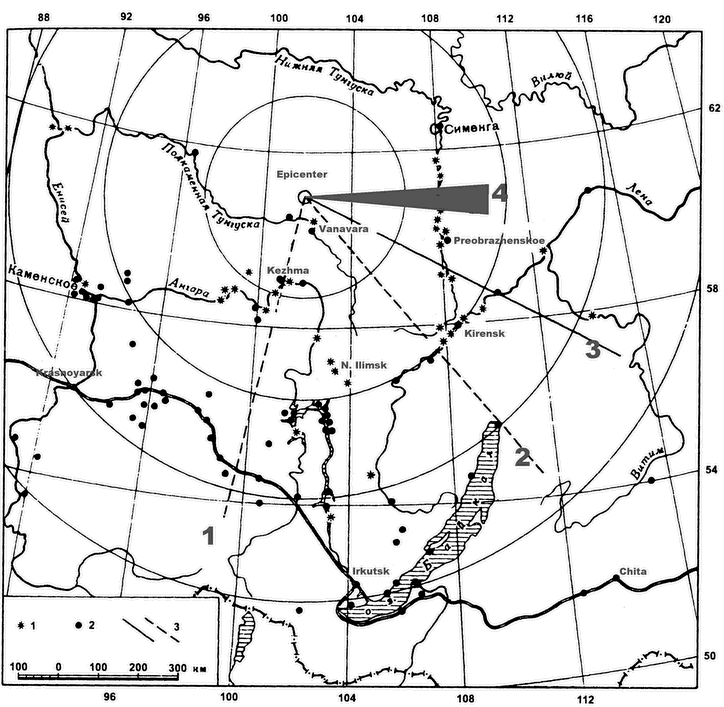
Let's read some witness's accounts.
Some details of the observed phenomena and especially the duration hardly conform to the meteorite fall.
Dyomin, Dmitriev, and Zhuravlev [1984] conducted analysis of "what did the witnesses see", based on complete data-set of the accounts [Vasilyev, Kovalevskii, Razin, et al., 1981]. The result is as follows:
Shape of the flying luminous body Percentage of accounts a ball-like 18.8 a cylinder 16.3 a cone-like 2.1 a star-like 3.4 a "tail-like" 14.0 a "snake-like" 2.3 a lightning-like 2.1 stripes of light 2.5 pillars of fire 4.9 a flame 10.3 a sparks-like 11.2 other forms 12.1
The eyewitness's accounts are hardly conformed with the meteorite fall. Even just in a few days-weeks after the event different time was given by different people, from early morning to the afternoon. So was the duration - from a few minutes to an hour. Astronomer Yevgenii Krinov, writing in his book "The Tunguska meteorite" published in 1949, about this side of evidence frequently uses phrases like, "the eyewitnesses either confused the cardinal points or just forgot the details".
All researchers noted, however, that the stories told by the local Evenks sounded true and were nearly always confirmed by other evidences later. The following story was typical for the area close to the epicenter. Two Evenk brothers, Chuchancha and Chekaren, sleeping in their tent (tepee) were suddenly awaken by shaking. They heard whistling sounds and "sensed a strong wind". One of them was pushed so heavily that his head struck a supporting pole and he fell on the hot embers in the fire-place. From outside came a hideous noise and sounds of trees falling. The brothers were about to dash out of the tent when a deafening thunderbolt clapped. The ground started to tremble and sway, and, a ferocious gust of wind toppled the tent. One of the men saw from under the immobilizing poles falling trees, their branches set on fire, and the dry unbrushed and moss burning. All the place was wrapped in smoke and it was so hot the brothers feared they "could be grilled alive". Suddenly a bright lightning flashed over the hill, as if another sun suddenly went up, and a series of thunderclaps followed immediately. Several more "lightning" flashes and claps of thunder, and the frightening sounds look like fading.
Evenk woman, Akulina, who was together with several Evenks in a tent (36 km, 121) said that suddenly "somebody strongly pushed our tent". Then it repeated again, and they fell on the ground. A loud noise came from outside, "somebody rattled and knocked the tent's cover". Suddenly bright light appeared, the bright sun was shining, strong wind was blowing". After "somebody fired (shot) and at once a whirlwind arrived". Akulina was frightened and lost consciousness. When she saw as a whirlwind "danced", she recovered. The whirlwind put her down. When she looked at the forest, she saw stems without branches and leaves. Many trees were put down. Wood bedding was burning. Ivan, her husband was thrown about 40 meters, his arm was broken and soon after he died (the another Evenk, who was in the tent told the same story, being interrogated independently).
Evenk, Ul'kigo (56 km, 176) said that suddenly in the early morning dogs began to howl, and small children cried. The persons inside the tent felt that "somebody began to knock the ground below them and to swing a tent". When Ul'kigo got out from the sleeping bag and began to put the clothes on, "somebody pushed the earth strongly" (right before it, "somebody fired from a gun a lot"). Suddenly again "just like somebody hit the earth". Utensils fell inside the tent. A loud thunderclap followed. When Ul'kigo got out from the tent, and looked at the sky, he suddenly saw a bright flash on the clear sky with following thunderclap. Ul'kigo was so frightened that he fell on the ground. He saw as wind put down trees and burning dry wood bedding. After Ul'kigo stood up, a whirlwind struck. The knocking, smoke and thunderclaps continued for some time.
Other eyewitnesses from the epicentral area gave similar reports. What has all that to do with the meteorite fall? Many other eyewitnesses also reported about luminous phenomena ( columns, stripes, lightning, flame, red sky glowing, etc.) which hardly resembled the meteorite fall.
Remarkably, that even supporters of the "meteorite fall" have to recognize that practically nobody of numerous witnesses saw any trail left by the "Tunguska fireball"...
Here is a translation from Russ. of a fragment of a letter sent by a prominent Soviet ethnographer I.M. Suslov ( about I.M. Suslov read here http://defendgaia.org/bobk/evenkiv.html ) to a Soviet journalist in 1961 (original in Russ. is taken from http://tunguska.tsc.ru/ru/science/mat/oche/31-60/d-041/ ):
So the stories if the poor people who flew over taiga were confirmed at the Munzhen. But how
could the hypothetical Tunguska spacebody generate the air-shock wave which transported the Evenks over the forest (already burning which hints that they were not far from the epicenter) and leaving them shaken but alive? It resembles tornado action...
Unfortunately the Suslov's article "Adgy" was never published...
Here is one of the most interesting accounts given by Evenk who was close to the epicenter. Here I just copy from the academician N.V. Vasilyev article https://www.bibliotecapleyades.net/ciencia/esp_ciencia_tunguska07.htm
------------------------------
"As I came to myself, he told Konenkin, I saw it was all falling around me, burning. You don’t think, Viktor Grigoryevich [V.G.Konenkin], that was god flying, it was really devil flying. I lift up my head - and see - devil’s flying. The devil itself was like a billet, light color, two eyes in front, fire behind. I was frightened, covered myself with some duds, prayed (not to the heathen god, I prayed to Jesus Christ and Virgin Mary). After some time of prayer I recovered: everything was clear. I went back to the mouth of the Yakukta where the nomad camp was. It was in the afternoon that I came there..."
Afterwards I.I.Aksenov repeated
his account in the presence of V.G.Konenkin and
V.M.Kuvshinnikov, an active participant of the Tunguska
expeditions. In this case, however, he said that he had seen the
"flying devil" not during hunting but in the
afternoon, when already in the camp near the mouth of the
Yakukta, also a tributary of the Chamba. The
devil was going flying southward along the Chamba. It was
going faster than airplanes now do. While flying, the "devil"
was saying "troo-troo" (which were not at all loud).
Later, during repeated questioning in Vanavara, he did
not insisted on having seen the "devil", repeating
nevertheless the other evidence. When evaluating Aksenov’s
account it should be borne in mind that the eye-witness regarded the
expedition people with distrust, considering them representatives of
the "authorities", and thus the contact with him was not at
all easy. On the contrary, his relations with V.G.Konenkin
were fairly confidential, the latter being a local resident and a
half-caste. Therefore, in our opinion, the first version appears
to be more authentic, because Aksenov does not seem to
have had reasons to lie to Konenkin.
What is the true meaning of this queer story and how
trustworthy is it, it is now hard to say. Without overrating the
significance of individual eye-witnesses’ evidence, note
nevertheless that at least two reports provided by those (very few)
eyewitnesses who were close to the epicenter of the Tunguska
explosion are really peculiar.
The accounts by Evenks are especially important as they are natural hunters and pathfinders, and their life depends on their senses and memory. So even Krinov who was used to write about "witness's confusion" had to recognize (in his book 'Tunguska meteorite', published in 1949) regarding Evenk's accounts that: "...we must note that many stories, as it later became known, during the expeditions, they proved remarkably accurate."
Please pay attention that the Evenks accounts conform with the geophysical interpretation of Tunguska.
On the basis of the eyewitness's accounts, three probable trajectories of the "Tunguska spacebody flight" were reconstructed (see also above). The first one was southern i.e. the meteorite flight from the south to the north (proposed and supported by Voznesenskii A., Kulik L. and Astapovich I. since 1920-s). Then in 1949 Krinov Ye. put forward the southeastern trajectory. Finally in the early 1960-s the eastern trajectory was proposed based on eyewitness accounts as well as on a pattern of the forest fall. Clearly, the meteorite could not have come from so many directions!
Remarkably that there are witnesses who stated that some anomalous phenomena commenced before 'fall' (i.e. before 00.14 UTC June 30, 1908). For example an outstanding Soviet ethnographer Sevyan Izrailevich Vainshtein
( http://en.tuvaonline.ru/2008/10/20/4204_vainshtein.html ) was in expeditions in the settlement Sulomay ( ~580 km to the west of the epicenter ) in the late 1940s. Some of the local residents were witnesses of Tunguska
( the Vainshtein's article in Russian is here: http://www.nkj.ru/archive/articles/14336/ ).
In brief: the witnesses stated that the anomalous skyglow commenced ~2 days before Tunguska! Also during Tunguska there was a windstorm in there which put down trees.
Vainshtein informed some scientists who studied Tunguska about the accounts after his return to Moscow, but the scientists did not believe them as the accounts contradict the meteorite-fall...
See about the Sulomay's accounts for details here in English:
https://onlinelibrary.wiley.com/doi/pdf/10.1111/ter.12453
Anyway there are several important conclusions from the accounts collected by Vainshtein.
1) There was the bright night phenomenon at Sulomay on the night June 29-June 30, and maybe even on the previous night[s]. The bright night phenomenon was in a very strong form.
2) A very bright bolide was seen near Sulomay on the "Tunguska morning".
3) There was a windstorm which put down tall trees near Sulomay on the "Tunguska morning". .
Sulomay is situated at azimuth 282.7 degrees and distance 577 km from the Tunguska epicenter. There is a second-hand account from the settlement of Podkamennaya Tunguska (Vasil'ev et al., 1981) which is situated at azimuth 282.3 degrees and distance 632 km from the Tunguska epicenter. The account stated about a seeing (on the early morning in 1908) as a fiery long strip flashed across the sky, and hearing accompanying thunder as from a cannon. There are numerous first-hand, as well as second-hand accounts about strong wind during Tunguska (Vasil'ev et al., 1981). One of farthest was from the place Yessey situated at azimuth 0.8 degrees and distance 843 km from the Tunguska epicenter (Vasil'ev et al., 1981). However Sulomay is the farthest known one where the wind was strong enough to produce a forest-fall.
The Tunguska accounts collected by S. Vainshtein confirm that manifestations of the 1908 Tunguska event were not localized near its epicenter, but spread over a rather large territory, including to far west from the Tunguska epicenter. Also the accounts confirm that bright night phenomenon commenced before the explosion.
It is important to mention that it is not the only case when eye-witnesses' accounts were rejected. For example here is what the prominent geochemist (and a researcher of Tunguska) Kirill Pavlovich Florensky wrote (Florensky,1955) regarding his trip to Tunguska in 1953 (translated from Russian by A.Ol'khovatov):Below here is a map by W. Fast of the famous "butterfly" pattern of the Tunguska forest-fall (its epicenter is 60.9 N, 101.9 E).
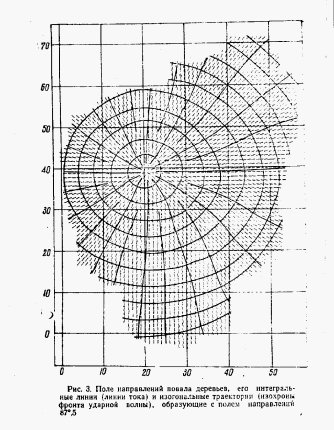
In 2005 Italian researchers with their Russian colleagues presented a new much more complete map. Here it is taken from:
---------------------------------
Giuseppe Longo, Mario Di Martino, Gennady Andreev, et al. - A new unified catalogue and a new map of the 1908 tree fall in
the site of the Tunguska Cosmic Body explosion //In: Asteroid-comet Hazard-2005, pp. 222-225, Institute of Applied Astronomy of the Russian Academy of Sciences, St. Petersburg, Russia, 2005.
---------------------------------
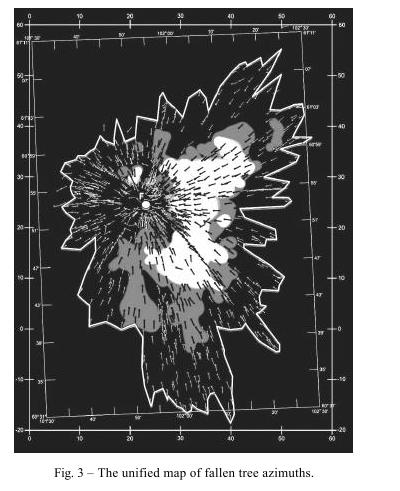
In the map there are several colors - it is so called 'reliability degree'. The Italian authors explain:
The reliability degree shows how well-ordered is the forestfall in some place/area.
Also it could be speculated that if to propose that Tunguska was an explosion and trees were felled by the air-shock-wave-caused aerial disturbance, then the trees felled by the Tunguska explosion should be fallen in approximately one direction (in some place/area).
So if in some area trees fell in approximately one direction then it is a good reason (in the frame of the proposal) to assign them to the Tunguska explosion. Such an area would have the high reliability degree. But if the trees lay in various directions in some place, then such an area would have the low reliability degree, as it is not completely clear whether the trees were uprooted by the Tunguska event indeed.
On the map it is seen that outer-borders of the forestfall have low reliability degrees. Near the outer-borders 'influence' of the Tunguska event was already small, and even directions of trees fallen by Tunguska may be affected by various local factors, and moreover as the number of the 'Tunguska uprooted trees' was small in there, so they could be 'dissolved' by trees fallen by other (none-Tunguska) reasons.
A remarkable feature of the map is absence of the high reliability degree to the west of the epicenter. In other words to the west of the epicenter trees were felled by Tunguska rather chaotically or/and their number was small and they were 'dissolved' by trees felled by none-Tunguska reasons. Both variants hint that the Tunguska explosion influence was rather weak to the west of the epicenter.
This is in agreement with result obtained by J.F. Anfinogenov and his group. In the mid-1960s J.F. Anfinogenov made a map of '100%-uprooting area' ( the map is based on aerial photo-survey conducted no later than 1949). Here it is from his (with Budaeva L.I.) book 'Tungusskie etyudy':
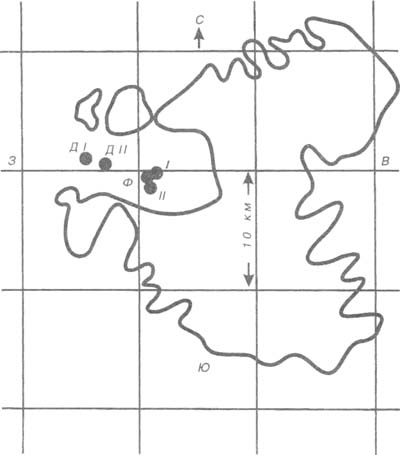
It is seen from the map that there was no 'total uprooting' to west of the epicenter!
This rather striking peculiarity of the Tunguska forestfall must be explained!
Let's look whether do modern numeric/computer stimulations explain the peculiarity.
Since mid-1960s numerous attempts were conducted to numerously stimulate the
forest fall by a meteoroid explosion (disintegration, to be exact). The researchers try to adjust parameters of the alleged spacebody fall (angle of its infall, its speed, energy, etc.) the best way to fit results into real Tunguska data.
One of the most detailed one was this one:
----------
http://adsabs.harvard.edu/abs/2007LPI....38.1537A
Lunar and Planetary Science XXXVIII (2007)
3D EFFECTS OF TUNGUSKA EVENT ON THE GROUND AND IN ATMOSPHERE. - N. Artemieva
and V. Shuvalov
----------
Here what they got (see Fig.2 with its signature and accompanying text from their work):
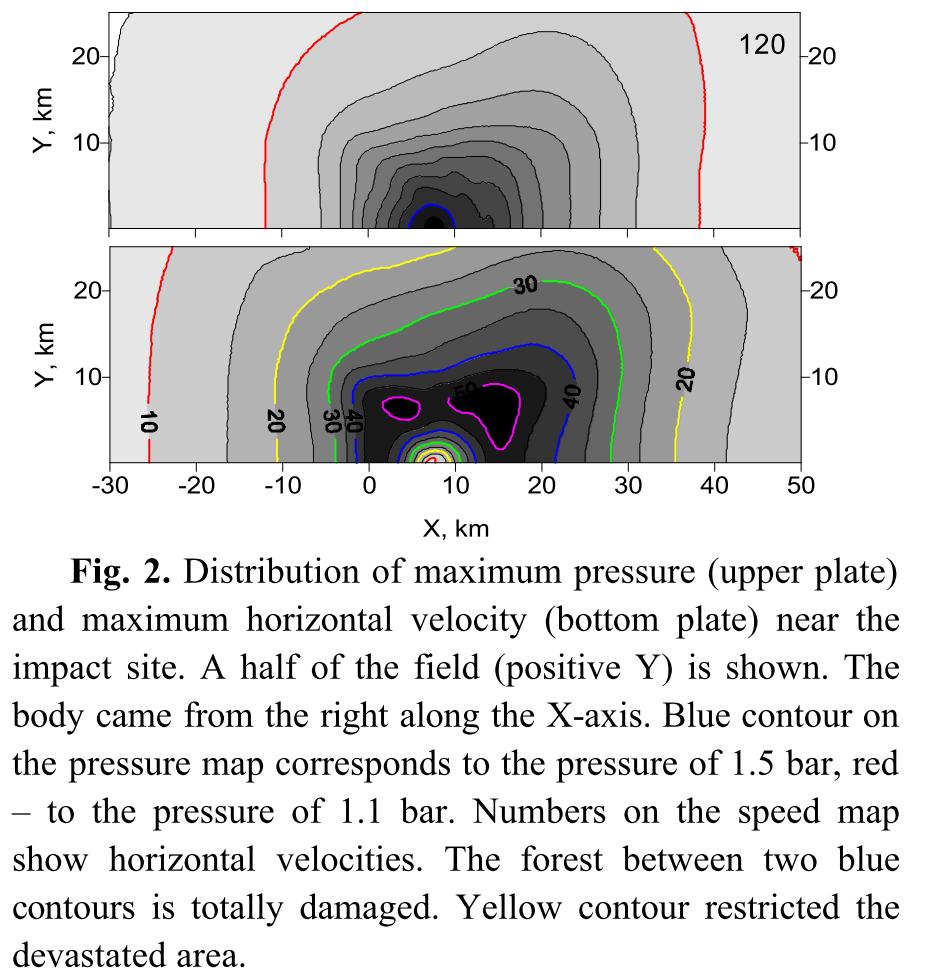
Remarkably that the authors of the modelling twice wrote: 'may be'... Or 'may be' not... Who knows... Who cares...
Anyway the authors of the modelling wrote that 'The forest between two blue
contours is totally damaged'. The above-given image by John Anfinogenov shows that to the west from the epicenter the reality is completely different.
Krinov wrote in his 1949 book ( from http://tunguska.tsc.ru/ru/science/1/2/8/ ) about some peculiarities of the forestfall (translated by Andrei Ol'khovatov with help of google-translate):
Here a map with living trees near the Tunguska epicenter (Florensky,1963). There are the following marks on the map: 1) directions flattened (uprooted) trees; 2) standing dry dead trees damaged by fire; 3) surviving trees; 4) the Kulik expedition's huts.
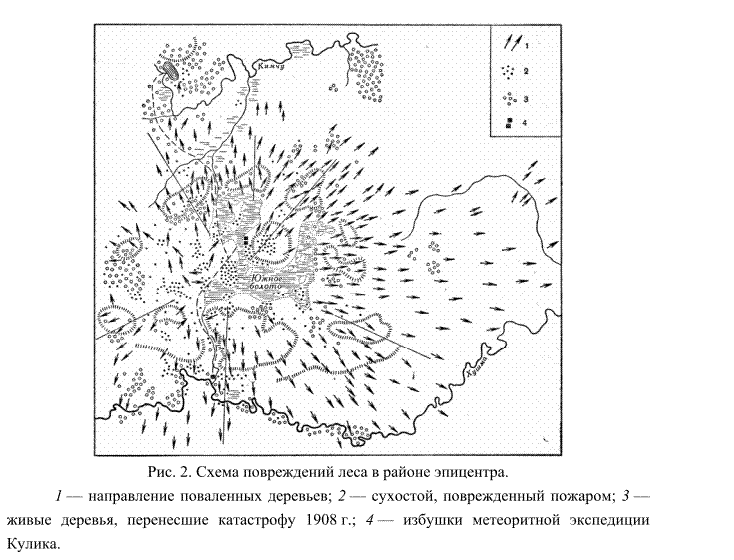
Another interesting research was done by Mark Boslough
https://share-ng.sandia.gov/news/resources/releases/2007/asteroid.html
In there Mark came to conclusion that 15 Mt energy deposition is too much as:
Anyway let's look at snapshot of the Boslough's video
http://www.sandia.gov/videos2007/2007-6514PFvmag-tun2.4.mpg
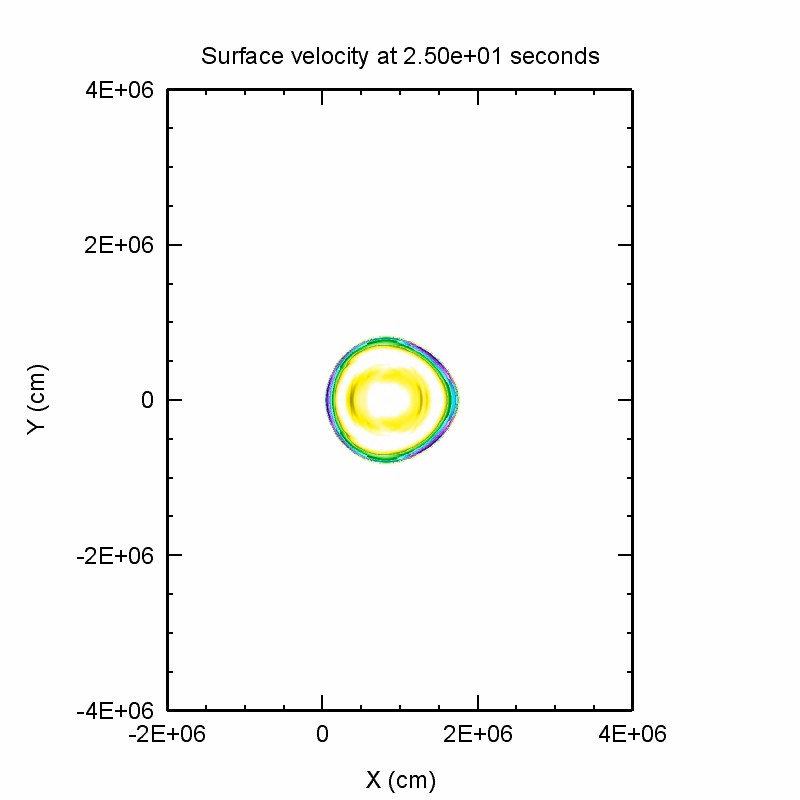
In 2008 Boslough presented at the conference in Moscow devoted to 100th Anniversary of Tunguska the following slide:
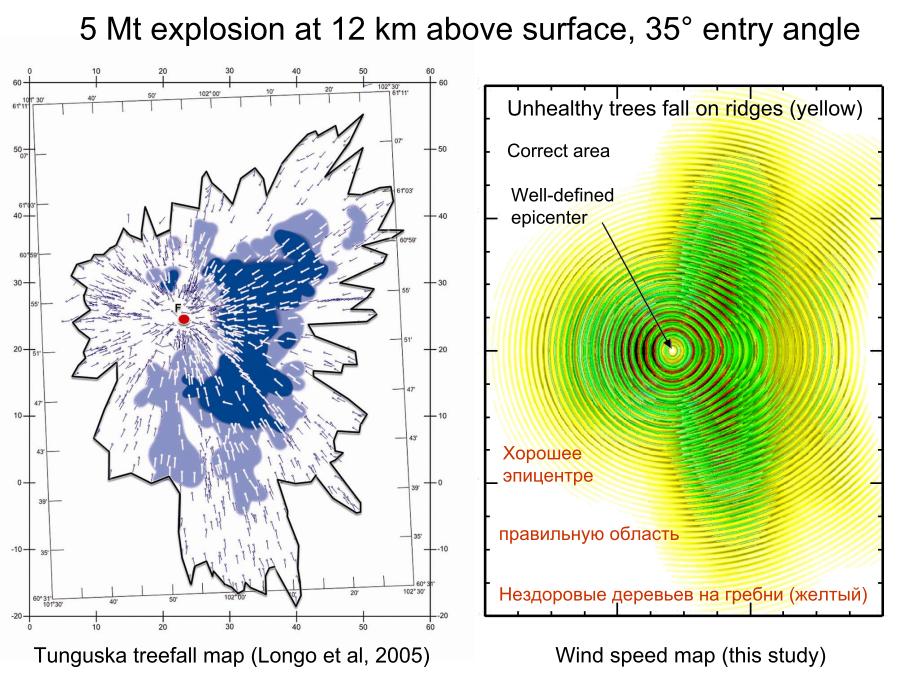
And here is one more important factor pointed out by Evgenii Ivanovich Vasil'ev. According to research by Aleksei Vasil'evich Zolotov (1969), concentrations of the fallen trees direction's intersections in the northeast part of the forestfall are inside this (i.e. northeast) part (see the left picture on the image below where red lines mean directions of the fallen trees).
(see http://tunguska.tsc.ru/ru/science/1/zol/4/12/ for details of the Zolotov's calculations)
Also concentrations of the fallen trees direction's intersections in the southeast part of the forestfall are inside the southeast part.
It looks like Boslough admitted some problems with accuracy of his modelling. So in the work published in 'Near-Earth Objects' Vol. 822 of the Annals of the New York Academy of Sciences May 30, 1997 'Shoemaker-Levy 9 and Plume-forming Collisions on Earth' by MARK B.E. BOSLOUGH AND DAVID A. CRAWFORD
there is some interesting info:
An obligation of argumented explanation of the Tunguska forestfall features lays on those who claim that: 'my work explains the forestfall'.
More than 2 decades past from that time but a model which can explain the 'only weak forestfall to the west' does not appear still...
Another intriguing detail of the forest fall is that despite the central area of the forest fall is often considered to be covered with standing trees, there are traces of the radial forest fall even in this area too! From the traces, Kulik even came to conclusion about 2-3 closely spaced epicenters!
It is also remarkable, that results of the 'Tunguska spacebody explosion' modelling point to an angle of inclination of the hypothetical spacebody trajectory must be about 40 degrees (otherwise it is not possible to get resemblance with the Tunguska forest-fall pattern (see the text above)), while from witness's accounts it must be no more than about 10-15 degrees. Indeed in the case of inclination of the trajectory 30 deg. and more the hypothetical meteoroidal fireball could be seen (from distances several hundred miles) just in directions close to the epicenter and relatively low in the sky, which does not conform with the eyewitnesses accounts.
Advocates of of the 'Tunguska spaceimpact' are well aware of the 'inclination problem' ( see for example V. Bronshten article 'Trajectory and orbit of the Tunguska meteorite revisited' here http://adsabs.harvard.edu/abs/1999M%26PSA..34..137B ), and try various 'tricks' to increase the inclination from the eyewitnesses accounts (the early trajectory estimations based on accounts gives the inclination just 7-8 degrees). However even such prominent advocate of the 'Tunguska spaceimpact' as V. Bronshten has to recognize that:
I hope that advocates of the Tunguska spaceimpact will model 'the combined action of the gravity field and a nonzero aerodynamic lift' to test the Bronshten idea. Till now it is not done, but other Tunguska researchers debunked the idea - see, for example, Andrei Zlobin's article here http://tunguska.tsc.ru/ru/science/tv/8/10/ where he evaluated needed aerodynamical overloads ). So the 'inclination problem' persists...
Detailed investigation of the Kulikovskii forest-fall conducted by various researchers has shown that there are remarkable deviations of the forest fall from the radial pattern all over the area. The deviations are shown on the picture below (out of scale). The deviations are larger to the east of the epicenter (especially large in the south-east sector of the forest-fall).
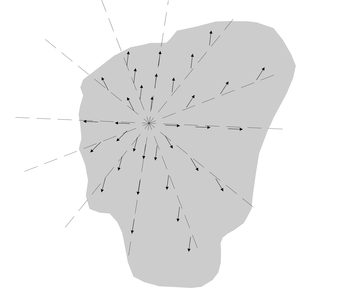
Another puzzle for the meteorite interpretation is the area of the forest fall on the ridge Chuvar (~24 km, 279), which according to the local Evenks have formed the same morning as the general (Kulikovskii) one. It was discovered by the 1959 expedition. Here is how it was discovered from a book by Vasil'ev N., Demin D., Erokhovets A., et al. - Po sledam Tungusskoi katastrofy. Tomsk, 1960. (translated by me = Andrei Ol'khovatov). The fragment says about a group of 3 researchers who explored a region to the west from the Tunguska epicenter in the direction of the mountain marked on a map as 'height-593'.
" Soon the terrain began to rise gently in the direction to the north-west. There was no forestfall already a long ago - it was over five kilometers from the Khushma-river already. There was the old larch forest around, which thickly overgrew the eastern margin of the foot of the height-593.
And suddenly the terrain landscape changed dramatically. The eastern slope was quite steep, and here, on this slope, the group again entered the forestfall zone, and even what the forestfall! Such a picture none of the three did see either on the Makikta-river, or to the south of the Hushma-river, or on the path of Kulik. The landscape seemed fantastic: huge trees, almost up to a meter across, were uprooted, sketched at each other, split like matches. All this, interlaced with red blocks of lichen-covered stones, seemed to be the trail of some devastating whirlwind, a tornado, a typhoon. At first the forestfall was completely disorderly; then (closer to the peak), trunks began to be located in a familiar way - the treetops in one direction, the roots in the other, but the direction of the fall of the trunks was directly opposite to that which is observed in the region investigated by Kulik: the treetops indicated here to the east, and the roots to the west. The impression was created that the group encountered a new center of catastrophe, lying about thirty kilometers to the west of Kulik's huts. "
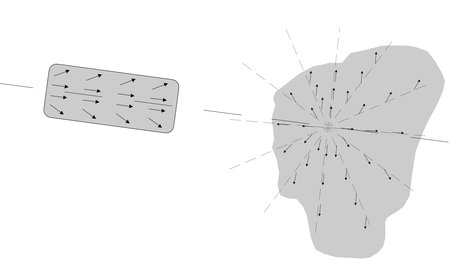
The Kulikovskii (right on the picture above) and Chuvarskii (left on the picture above) forest-falls resemble as produced by intensive air-jets (like meteorological downburst and burst swath - see also below).
By the way, there are reports about more forest-falls appeared about June 30, 1908 in the region. Here is just one example from English translation of the L.A. Kulik early report ( https://ui.adsabs.harvard.edu/abs/1935PA.....43..499W/abstract , http://articles.adsabs.harvard.edu/cgi-bin/t2png?bg=%23FFFFFF&/seri/PA.../0043/600/0000501.000&db_key=AST&bits=4&res=100&filetype=.gif ):
"More concrete data about the destruction of the forest by a wind blast are furnished by an inhabitant of the village Krasnoyarovo, of the district of Kirensk, of the government of Irkutsk, V. M. Arbatsky, in answer to a questionnaire of the Meteorite Expedition. After giving a description of the phenomenon, containing nothing new, he adds: "In the region reached by going from the small river Tunguska along the little river Ayan for about 15 versts, I noticed a broad strip of completely uprooted forest, extending along the road for about one verst. As for the more remote regions [i.e. farther away from the road] I have no knowledge." "
In the more complete version of the V. M. Arbatsky account he wrote about the forest-fall at the Ayan river that "in the same year and the month, the day is unknown...". Arbatsky added that many residents of the village Krasnoyarovo are witnesses of that.Some cases of the ignition of wood bedding were reported up to 34 km
from the epicenter [9] and even probably farther (see section 2.1). But
according to the Tunguska meteorite model it means that everything alive
would completely burn at the epicenter. For example, according to the Tunguska
meteorite model, the radiant exposure at the distances 5-9 km from the
epicenter is about 300 J per sq. cm [7], but it means that right at the the epicenter the radiant exposure is about 1200-1700 J per sq.cm!
(LATER ADDITION: Interestingly that a decade later i.e. in 2006 V.V. Svetsov confirmed this: "Numerical simulations [3,4] show that the thermal energy delivered to the ground by radiation peaks at about 1 kJ/cm2 at the explosion epicenter." (Lunar and Planetary Science XXXVII (2006), abstr.1553)).
In 2019 there was an article 'A model for thermal radiation from the Tunguska airburst' by Christopher O. Johnston , and Eric C. Stern in ICARUS v.327, pp.48-59. Rather interesting article but there is one big problem with it - it considers a source of the burn ('Tunguska bolide') too high above the ground, while all published research on locating the source of the burn (several methods were used by several groups of authors) locate the source at about 5-6 km altitude (or 7 km at the most). Higher altitude is very unlikely, while there is some small possibility of lower altitudes.
If somehow to 'adjust' the radiant exposure to lesser values, then this helps a little, as the key peculiarity of the burn is its spotty (irregular) character. A good illustration of this is a map of the trees burn by L'vov Yu.A. and Vasil'ev N.V. (Voprosy meteoritiki, Tomsk,1976; unfortunately the quality of production-printing of the article was not good):
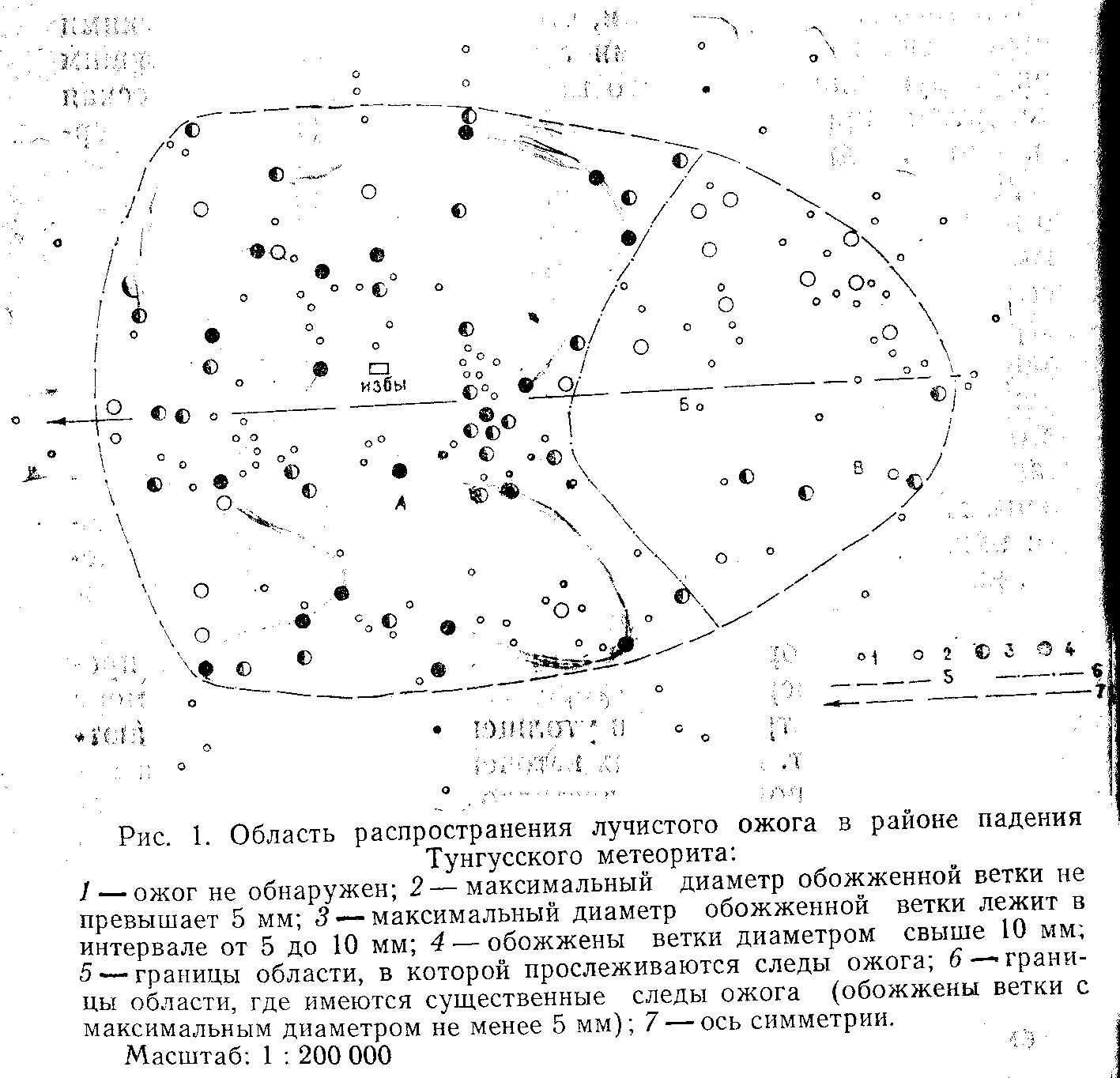
There is another map (to better understand position of the tested trees ) by V.A. Vorob'ev, A.G. Il'in and I.K. Doroshin (Fenomen Tunguski, Nobosibirsk, str.9,2008) which is shown below:
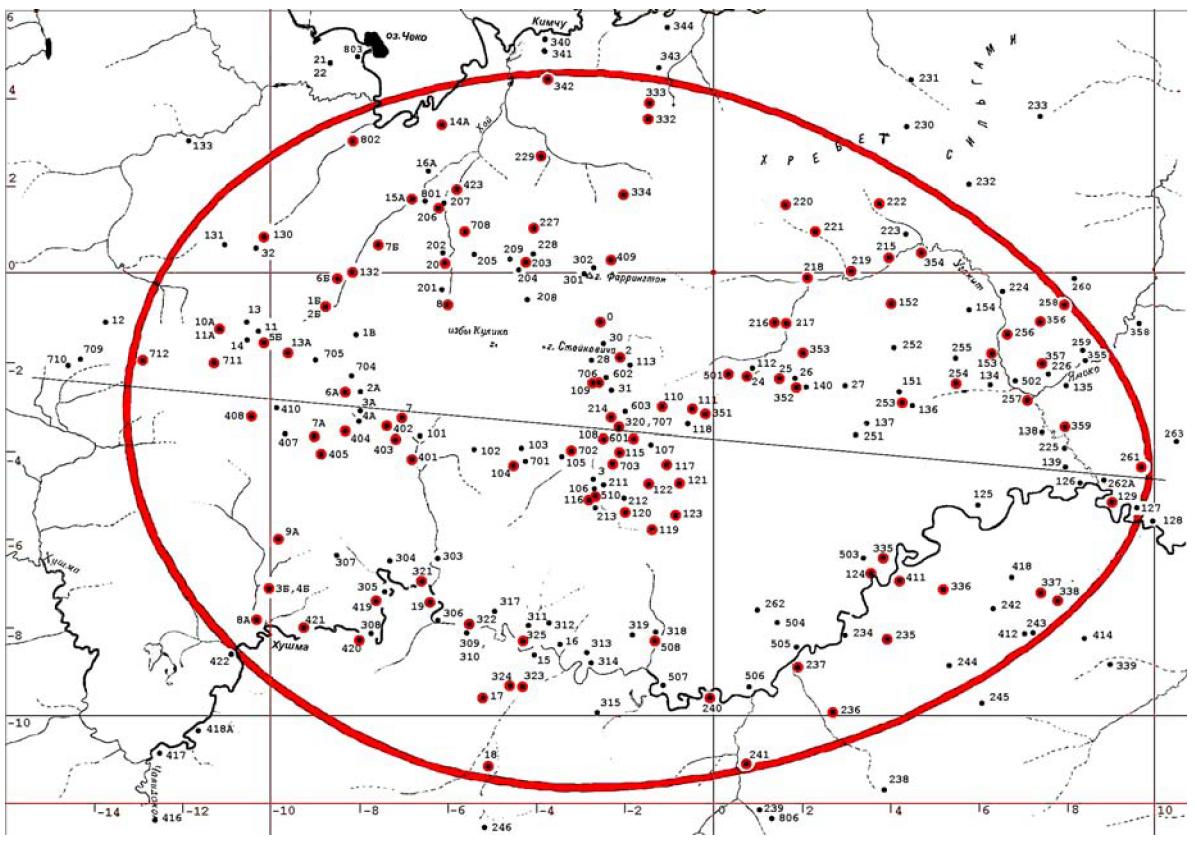
Regarding the forest fire - it was also peculiar. It was was rather moderate (or even weak) and started in many places ('spotty' - separated by 'no-forestfire' areas) in the region (simultaneously, as experts write), and it was almost stationary.
From the character of the trees damage it concludes that at first was the breaking of branches and then a burn at the site of the break [9, 12]. In other words, for the meteorite explosion interpretation it means that the air-shock wave from the explosion came faster than light impulse!
The author also would like to mention the local Evenks reports about spots of melted sand and soil.
Here are just several examples of the seismic phenomena accompanied the Tunguska:
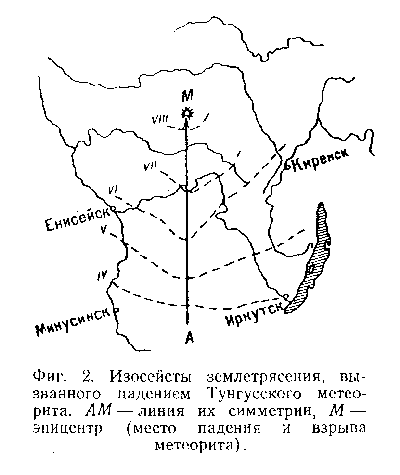
There are several intriguing aspects of the seismic observations. As, for example, that in some places seismic disturbances occured several hours later than in others. This effect is a typical for all witness's accounts data, as it was discovered by Dyomin et al. in 1984, and the effect is not on a border of statistical dispersion, but forms a secondary weaker statistical maximum at about 12 noon.
Another aspect is the long duration of the seismic events (up to 45 minutes) as reported by numerous witnesses. It is in complete agreement with recordings by nearest Irkutsk seismic station (see below).
Such behaviour of seismic waves generated aby a bolide air-burst is clearly seen with the 2013 Chelyabinsk bolide, where (from Heimann S., Gonzalez A., Wang R., Cesca S., Dahm T. - Seismic Characterization of the Chelyabinsk Meteor's Terminal Explosion - Seismological Research Letters, 2013. Vol. 84. N6. p.1021):
Interestingly, there is a report from the Stepanovskii mine, a short distance from the town of Yuzhno-Yeniseisk, that an earthquake struck this area at 23.43 UT June 29, i.e. a half hour before the "fall of the Tunguska meteorite" [5].
No any "Tunguska meteorite" fragments were discovered. And many years ago it was proposed that the meteorite completely burn out into dust (even despite that it resembles a story about a snake which completely swallowed itself, commencing with its tail...). Recently the attempt was done to calculate the burn-out [7,17]. In the author opinion this attempt can't explain the absence of the fragments, because:
a)Even the results of [7,17] conclude that it must be a lot of small fragments a few kilometres from the epicenter. As already mentioned, despite many years of careful search - no one found. And no large quantity of extraterrestrial dust (droplets) was found in the epicentral area. The results of a search for globally dispersed the meteorite dust also are negative [18].
If you are interested in Tunguska geochemistry, then I would like to advise you to read this group of articles by Evgenii Kolesnikov with coauthors. Kolesnikov wrote many articles on "discovering Tunguska spacebody substance"
since late 1970s. Here is a link to an article by Rasmussen, Kaare L.;
Olsen, Hans J. F.; Gwozdz, Raymond; Kolesnikov, Euginev M.:
"Evidence for a very high carbon/iridium-ratio in the Tunguska impactor"
(
METEORITICS & PLANETARY SCIENCE, vol. 34, no. 6, pp. 891-895 (1999)).
But their results on composition of the "Tunguska spacebody" are
so unusual (if not strange), that it produced some argue by geochemistry's experts:
METEORITICS & PLANETARY SCIENCE, v.36, p.999-1006 (2001).
An Italian reseacher Prof. G.Longo also doubts in reality of these chemical anomalies writing in his article 'The Tunguska Event' (Comet/Asteroid Impacts and Human Society, An Interdisciplinary Approach (2007)):
So if even minor geochemical peculiarities possibly were detected in the "impact place" [16], there is no reason to claim them as of 'Tunguska spacebody', because of their composition. The latter one doesn't resemble a chondritic meteorite, neither a comet (as even pristine ice-rich cometary material is supposed to have a chondritic complement of about 50 wt% [18]).
I can add that the deuterium to hydrogen ratio (D/H) in the Tunguska "catastrophic" peat layer is less than in the adjacent ones (and, much less than in ocean water, of course), while the D/H ratio in all 3 researched comets (Halley, Hyakutake, and Hale-Bopp) is on contrary much larger than even in the adjacent peat layers.
Also isotopic ratio for Tunguska epicenter's rare Earth elements (REE) which was measured in the place of the most REE enrichment is the terrestrial one.
Regarding C-14, its data is rather contraversial, but the latest measurements seem to show no significant deviations against background.
And what about to propose that over the epicenter the
extraterrestrial substance was dispersed into fine microparticles
during the powerful Tunguska explosion and flew away, explaining why
there was no fall out? The answer is "hardly". For example, the latest
published calculations of the hypothetic Tunguska spacebody's explosion
show that a plasma column of the remnants was to strike the ground.
And as it is known. in the case of a powerful nuclear explosion
significant part of radioactive debris falls out not far from its
epicenter. So this scenario (99.999...% of the substance flew accurately
far away from the epicenter) looks very unlikely (impossible in reality).
But the problem is even much more deep. Where is enormous quantity
of extraterrestial substance, which the hypothetic Tunguska body was to
lose before its explosion? Indeed, according to practically all
calculations, the hypothetic Tunguska spacebody was to loose a
significant (probably even dominated) portion of its mass before it
reached the explosion altitude of 5-8 km. In other words, at least,
a hundred thousands tonns of extraterrestrial substance (from
large fragments to dust) would be deposited along the lower part of
Tunguska spacebody trajectory. Despite many years of careful search
nothing was discovered... By the way, a couple years ago application
of just one of the many Tunguska substance search's methods allowed
easily find small fragments of a meteorite (with initial mass of
several tonns, probably), which disintegrated over another place in
Siberia in 1904...
The absence of discernable nitrate excess (produced by the "Tunguska meteoroid" during its descent) is also a problem for the meteorite interpretation [18].
There is also some interesting ice-core data relating the year 1908. Here is from http://adsabs.harvard.edu/abs/2009arXiv0907.1067M
We estimate atmospheric chemistry changes from ionization for the 1908 Tunguska airburst event, finding agreement with nitrate enhancement in GISP2H and GISP2 ice cores, noting an unexplained accompanying ammonium spike. We then consider the candidate cometary impact at the onset of the Younger Dryas (YD). The estimated NOx production and O3 depletion are large, beyond accurate extrapolation, but the ice core peak is lower than predicted, possibly because of insufficient sampling resolution. Ammonium has been attributed to biomass burning, with a coincident nitrate spike found at YD onset in both GRIP and GISP2 ice cores. A similar result is well-resolved in Tunguska ice core data, but that forest fire was far too small to account for this. Direct input of ammonia from a comet into the atmosphere is adequate to explain ice core data at the YD event, but not Tunguska data. An analog of the Haber process with hydrogen contributed by cometary or surface water, atmospheric nitrogen, high temperatures, pressures, and the possible presence of catalytic iron from a comet could in principle produce ammonia, accounting for the peaks in both sets of ice core data.
For more you could read the whole article from the link above.
Here are my comments of the article.
- Authors accepted the speed of the Tunguska spacebody about 30 km/s. At such speed the spacebody unlikely to penetrate to low altitudes ~ 6 km unless it was exceptionally strong. But then it couldn't have been a comet!
- There is an interesting fragment in the article:
To compute an equivalent value from the simulation results, we sum the rate at the 75
degree North latitude band over 90 days following the event, which gives a net peak
enhancement value of about 1.50 x 10-6 kg m-2, in good agreement with the ice core
result.
...
Anyway even such 'loose' approach failed to fit the data with ammonium, so the authors wrote:
And finally, one more interesting fact. Chemically robust carbon particles
(probably diamonds) were found near the epicenter [21,22]. Their composition
leads to the conclusion of their terrestrial origin [21,22].
Here is a the from [22] (http://adsabs.harvard.edu/abs/1995Metic..30S.521H ):
The Tunguska impact event of 1908 caused the destruction of a large forested area but left no impact crater. It was interpreted to have exploded in mid-air and thus would disperse material in a fireball over a wide geographical area. Several attempts have been made to locate particles associated with the impact in materials such as tree resin (1) and even in Antarctic snow (2). One of us (JN) attended an expedition to the Tunguska impact area and collected samples of peat from a depth of 60 cm which is thought to be the level in the peat which holds the impact horizon and indeed contains charred vegetation. The peat was subjected to standard demineralization procedures using mineral and oxidizing acids to destroy all but the most resistant mineral phases. An emphasis was placed on the chromic acid treatment to remove organic carbon as the peat was inevitably of extremely high organic content but perchloric acid was also used to oxidize graphite. The residue after treatment has subsequently been examined using a scanning electron microscope (Jeol JSM-820I at 30kv) with a Kevex system to obtain an energy dispersion scan and subjected to stepped combustion to determine the carbon abundance and isotopic composition. The SEM revealed the predominance in the residue of chromium containing phases possibly as a result of the extensive chromic acid treatments but several very pure carbon-rich particles were also observed. These carbon particles were anhedral and up to 15 micrometers in size. Due to the nature of the acid treatment performed upon this sample only a very robust form of carbon could survive and the most likely mineral is diamond. Further analyses using a transmission electron microscope and selected are electron diffraction will be performed to resolve the true mineralogy of these carbon particles. Stepped heating experiments on the acid resistant residue in conjunction with static mass spectrometry (3) has been used to give both carbon and nitrogen contents as well as carbon and nitrogen isotope compositions. Carbon accounted for 0.6% by weight of the residue and was released between 550-650 degrees C with a delta^(13)C of -25 per mil. The nitrogen yield was 0.02% by weight of nitrogen released between 500-700 degrees C with a delta^(15)N of ca. 0 per mil. These represent terrestrial values and indicate that the carbon particles do not have an extraterrestrial signature. If indeed these carbon particles are diamond and related to the explosion of the Tunguska object then they may well have formed by a plasma process within the fireball (similar to CVD). Further refinements regarding the purification of acid resistant materials are in progress. References: [1] Ceccini S. et al. (1995) in Abstracts Presented to ESF Network on Impacts Meeting, Ancona, Italy, May 12-17, 1995. [2] Roccia R. et al. (1990) GSA Spec. Pap. 247, 189. [3] Wright I. P. and Pillinger C. T. (1989) USGS Bull., 1890, 9.
For more on the geochemical anomalies - see pos. 3.10.
Trees of the second post-explosion generation exhibited higher than normal growth rates in the woodland area devastated by the explosion [23]. In recent decades, the boundaries of the high growth rate zone were "drawing in" toward the eastern "trajectory". Here the frequency of genetic mutations among the young pine trees has increased 12-fold. Till now the meteorite interpretation doesn't explain it.
The unusual glow in the sky was first observed days before the event [23]. Beginning on June 23, 1908, atmospheric optical amonalies were observed in many places of Western Europe, the European part of Russia and Western Siberia. They gradually increased in intensity until June 29 and then reached a peak in the early morning of July 1st. These anomalies included an unprecedentedly active formation of mesospheric (noctilucent) clouds, bright "volcanic" twilights, disturbances in the normal motion of the Arago and Babinet neutral points, a possible increase in the emission of the night sky, and unprecedentedly intense and long solar halos. Later on, after July 1, these effects decreased exponentially [23]. The area involved in these phenomena was limited by the Yenisey river in the East, by the Tashkent - Stavropol - Sevastopol - Bordeaux line in the South, and by the Atlantic coast in the West [23].
For example, here is what a prominent meteor observer William Frederick DenningIt's very hard (practically impossible) to explain it even by the comet dust, because:
a) Nobody saw the comet. If it even existed it must be very small. When the Earth crossed a trail of the large spectacular Halley comet in 1910, it produced a weak (if any) effect.
b) For a few days the trail must cover all the Earth around. But the glow was localized in the Europe and the west Siberia in general. Moreover, there were no any reports of the glow in the event region, while the hypothesized cometary coma must be the most dense near its nucleous, i.e. affect the impact region the most.
c) Comet dust must stay in the atmosphere for many weeks, while 'light nights' disappeared in a few days.
d) The enormous quantity of extraterrestrial dust (to produce the prominent sunlight scatter) must strongly influence on the atmospheric absorption. But no unusually large absorption in the atmosphere was detected on the days of the glow (see section 3.12).
e) The sky glow was also observed at rather low latitudes, where it couldn't be originated by the scattering of the sunlight by the dust at night.
It is just a small part of the meteorite interpretation problems. The supporters of the meteorite interpretation usually try to ignore them. For example, when you are talking about the incompatibility between eyewitness's accounts and the meteorite interpretation, they use to say that the eyewitnesses often confuse and so on. But on the other side, the whole idea about the meteorite is based just on the eyewitness's accounts about flying fiery body!
As the Tunguska energy according to 'the best calculations' ( https://share.sandia.gov/news/resources/releases/2007/asteroid.html ) was about 3-5 Mt (i.e. just 6-10 times greater) then it is a good reason to compare.
Here are several points.
1) The 2013 Chelyabinsk was a 'classical' large bolide
with no Tunguska-like anomalies, no earthshaking preceeding the bolide etc.
Nothing like
'two giant fiery circles which persisted for 4 minutes' as in very reliable report from Kezhma in Tunguska.
2) In Irkutsk (almost 1000 km away from the Tunguska epicenter) after Tunguska a geomagnetic disturbance was registered which lasted for several hours.
In the 2013 Chelyabinsk modern geomagnetic detectors measured nothing similar despite being several times closer to the event.
3) The 2013 Chelyabinsk meteoroid main body disintegrated at altutudes about 30 km. The hypothetical Tunguska meteoroid disintegrated just at 5-10 km altitude (as advocates of the Tunguska meteorite theory say) so it had to be much stronger. So what did it consist of? Iron?... :)
4) There is nothing similar to the famous Tunguska 'bright nights' in association with the 2013 Chelyabink. It looks like some noctilucent clouds were seen IN A WEEK after the 2013 Chelyabinsk event over Europe (which doesnot contradict to the meteorite theory) but in Tunguska the glow phenomena appeared SIMULTANEOUSLY with the event and in a weaker form even PRECEEDED the event and then fastly disappeared in a few days.
5) In the 2013 Chelyabinsk event seismic phenomena reported by witnesses were concentrated within several dozens km from its 'explosion place' (this was caused by a shock wave hitting the ground some dozens seconds after the bolide pass - quite in agreement with a meteorite theory), while the bolide was seen at distances up to ~700 km.
In Tunguska while the VARIOUS luminous phenomena were reported up to about similar distance, but RELIABLE reports on seismic effects were reported at distances larger than 1000 km! (see this www-page nearby) which the meteorite theory can't explain (and this hints that there were several sources of seismic waves in the region).
The manifestation of the seismic effects even BEFORE appearence of the 'Tunguska bolide' is also a problem for a meteorite theory.
6) THE SUBSTANCE. There is a lot of reports of finding the 2013 Chelyabinsk meteorite substance. The reported meteorite fragments vary from 'pea'-sized to more than 600 kg piece. In December of 2013 a tourist group of 'visually impaired' people(!) discovered 24kg-sized fragment. And what about those fragments which were not openly reported, as the fragments are rather expensive and for many poor local residents they are theasure...
According to some initual mass-media reports from the area some people collected small fragments with buckets...
Nobody could demonstate even a single small fragment of Tunguska while fragments of the hypothetical 'Tunguska meteorite' should be concentrated in a rather small area
(see Hills, J. G. and Goda, M. P. article: http://adsabs.harvard.edu/abs/1993AJ....105.1114H ).
The area was searched for many decades even with various methods - the outcome was negative.
And much smaller the 2013 Chelyabinsk disintegrated at ~30 km altitude and had a shallow trajectory so 'dispersed' its fragments over large region - a lot of fragments!...
All above-mentioned facts can be explained on the assumption that the Tunguska event was a terrestrial phenomenon, in which tectonic processes played a very large role. One of their manifestations is well-known - it is rupture and trembling of the ground, i.e. an earthquake. But now let's look at some others.
A surge in tectonic activity may produce various optical effects in the atmosphere: luminous columns, stripes, lightnings, flame, glowing sky, etc. Exploding "meteors" are among them.
Here is from http://abob.libs.uga.edu/bobk/ccc/cc042600.html :
...Rada has dug up a Chronicle of Aleppo (a major and very old city in Syria***) that was written down in 1926 - and the author had talked to an eyewitness of the great earthquake that had hit the city in August of 1822****). (Rada actually said August 1, 1821, but all sources I tracked down on the net say either August 13 or 23, 1822.) And what that witness has to say was really weird. From Rada's 'live' translation I got something like the following scenario:
- The witness was sitting in front of his house during a cool night.
- Suddenly the air got so hot that he couldn't breathe, and that
extreme heat lasted for some 20 minutes.
- Then he saw a bright light in the atmosphere that lit the whole
ground like sunshine. He describes the light like as if a "chamber
had opened in the sky."
- Next he heard a sort of great noise like thunder, and
- the air started to move left and right.
- Four shocks lifted him and others out of their seats, and they
were fearing for their lives, as if the sky would be falling.
- And then buildings all around them started to collapse, less than
30 seconds after the bright light had appeared, with the earthquake
and its aftershocks lasting for 40 days.
Here is how the onset of an earthquake at the Russian town of Kola began on February 21, 1873. The weather was calm. Suddenly it became dark and then an enormous fireball of a dark crimson color appeared in the eastern sky and vanished in the west. At this time underground jolt occurred and the earthquake began which lasted for 5 minutes. It was so strong that the houses swung and utensils fell.
Another interesting example. The "meteor" flew at low altitude in a blast of wind over the Russian town of Chembar past midnight on January 4, 1886, exploding on the road out of the town with loud thunderclap. This explosion killed a horse. Later the survived driver (coachman) just could tell that fiery serpent came flying and killed the horse. About 15 minutes after the explosion an earthquake struck the town.
These exploding fireballs happen in connection with many earthquakes. Some of them are mentioned in [24]. Here is an example.
During the earthquake in the Tama Hills, Japan June 17, 1931 "a fireball rose in the sky and disappeared. A sound like "Bah..." was heard. The lower sky was coloured pink-red for some time after the disappearance of the light".
The author thinks that everybody who are well aware of the eyewitness accounts near the Tunguska epicenter marks the similarity between these phenomena.
And one more very important observation proving that such luminous phenomena can be something more than just simple "lights". During the South Hyuga, Japan earthquake November 2, 1931 [24] a fishing boat called the "Ikedamaru" was engaged in fishing on the sea about 50 km off Utiumi, a town on the coast of Hyuganada. Near the time of the earthquake the boat began to pitch so heavily all of a sudden that the crew thought she was near being capsized. At the same time, to the crew's consternation, a large pillar of fire shot up from the surface of the sea near the boat.
During Matsushiro moderate earthquake's swarm in mid-1960s earthquake lights were pictured the first times. Below is a photo of stable glow (which lasted for 96 seconds) taken Sept.26, 1966 (from J.S.Derr: Earthquake Lights...// Bull. Seism. Soc. Amer., 1973, v.63, p.2177).
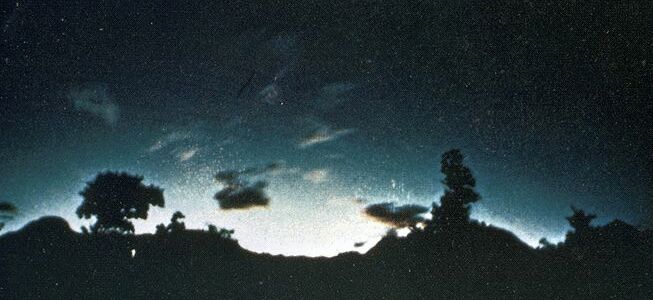
On April 22, 1974 immediately before the earthquake hit Kiangsu province in China, people saw a bright streak of light in the sky. Sparkling and glittering with the "lightnings" dancing across it, it proceeded from southwest to northeast. The spectacle went on for some 3-4 seconds. In another Chinese province, Liaoning, fiery columns and balls flashed up in the sky on February 4, 1975, and a "flame" shot up toward the sky at the time of the earthquake. The precursors of the Tangshang earthquake in the Chinese province of Hopeh on July 28, 1976, were revealing in a way. About a half hour before the disaster, a bright flickering light was spotted in the distance. Instantly it was transformed from red to silvery blue, and then lengthened into a blinding white strip that darted across the sky and went out immediately. The eyewitnesses had the impression of a nuclear explosion. At the time of the earthquake an engine driver saw a lightning in the form of 3 blinding light beams, which were followed by 3 mushroom-shaped smoke columns.
A very interesting luminous phenomenon was seen a night before aftershock M=5 of the 27 May, 1976 Lungling earthquake (China) [25]. Two Chinese seismologists observed a fireball about 50 metres in diameter 200 meters away. They watched the fireball for almost half an hour. Next morning at the fireball's site they found "an extensive remnant of a sand boil" [25]. Why not the Muong Nong type tektites production on mini-scale?
A great number of luminous phenomena was seen before the Sungpan-Pingwu (China) earthquake, August 1976 [25]. Columns, fans, balls and sheets were seen. Several Chinese seismologists observed on the evening July 21 a small fireball, which originated at the ground surface about 100 meters from where they stood. At first, it was about 1 meter in diameter. It then shot up to a height of 10 or 15 meters, whereupon the volume started shrinking, finally to ping-pong-ball size. After reaching the maximum height, the ball curved over in an arcuate trajectory, resembling a meteor and disappeared as it fell to the earth. The light would dim, then brighten again. Small wisps of white smoke swirled around the light, and a slight crackling sound was heard. A radio compass and telluric currents were unaffected. A small fuunnel-shaped hole in the ground was found at the place where the fireball appeared. In another case, a fireball started near a house, rose up along an arbor, and burned a hole in the roof of the house. A total of about 1000 fireballs were sighted, 50 in one evening. Chinese seismologists discovered that more fireballs occurred along intersections of river beds and faults [25].
In connection with the swarm of earthquakes in Quebec, Canada 1988-1989 a lot of luminous phenomena were sighted: sparklings, dawn-like diffuse glow, aurora-like bands [26]. Fireballs a few meters in diameter often popped out of the ground in a repetitive manner at distances of up to only a few meters away from the observers. Others were seen several hundred meters up in the sky, stationary or moving. Some observers described dripping luminous droplets, rapidly disappearing a few meters under the stationary fireballs [26].
A very important results on the earthquake lights were recently obtained in relation with the 1995 Kobe earthquake. The investigation of the place where during the earthquake several "streaks of bluish-white color spread out for about a second" (for details see "Geophysical Research Letters v.25, p.2721 (1998)) revealed the traces of 1000 A electric current through the area of about 1000 sq. cm. (Dr. Y. Enomoto, personal communication (1998)).
Very interesting pictures of earthquakes lights and "their" burnt rocks preceding the 1999 Turkish earthquake can be seen here).
It is important also to add that there are some signs of a relation between regional lightning and shallow earthquakes (see "Geophysical Journal International" v.131, p.485 (1997)). Remarkably, that during 19th century an idea was popular that earthquakes are of electric origin!
In general "tectonic lights" could be "meteors", pillars, rays, shooting up flame (usually in an epicenter), semispheres, fireball, patches and bands (in the sky and on the ground), all-sky luminosity, flashes, "auroras", sparks, "clouds", black objects and many others. They have some tendency to move towards an epicenter of an earthquake. Also, please, pay attention, that sometimes earthquake lights accompanied very weak earthquakes.
As we saw, many of these "lights" display energy release, sometimes explosion-like character. Usually these events happen in connection (prior, at the time or after) with earthquakes. But sometimes (see below) the accompanied earthquakes are very weak and an energy release by explosive event exceeds an earthquake one. Also as they often look like an explosion of a flying luminous body, they also can be called as a geometeor).
Indeed, more and more data appears showing that geophysical medium (at
first, soil, rock) is a complicated nonlinear active system possessing
its own "memory". Such a medium is to be characterized by
self-organizing
and self-adjusting processes in it. Possibly that geometeors are just one of the
way of such self-organization [27]. Remarkably, that atmospheric processes
play an important role in geometeors, i.e. probably geometeors is self-organization
in/between two geospheres: solid Earth and atmosphere (and maybe outer space medium too?).
The author inclines to think about a possible role of water vapour.
It is remarkable that geometeors (as well as luminous phenomena in general) rather often occur at certain places and very seldom in others (it seems that such geometeors-areas often don't coincide with areas of increased seismicity, but lie close to them).
Till now we don't know their physical mechanism. The author doubts that it could be explained just by electromagnetism, at least by known forms. Probably we must add something. Maybe just this self-organization? Probably research on a 'classical' (associated with weather) ball-lightning could help. The author have an impression that they are just "the top of an iceberg" (one of the most clear manifestations) of some universal fundamental process (of self-organization?)[27,28].
In typical cases geometers looks like an appearence of luminous body (sometimes it could be dark and probably even invisible) which travels to some site (or originate at the site). Then it could explode.
Unfortunately, a number of known high-energy geometeor, which aren't connected with large earthquakes a rather small, so features of geometeors are not well-known (for the latest development see my geophysical meteors article). Anyway, two properties are rather well-established already:
Geometeors often resemble (look like) explosions of ball lightnings. So in many cases we could say that it was the explosion of the ball lightning endogenic (tectonic) origin (if there is a clear role of tectonic activity). Who knows, maybe geometeors could help better understand when and where better try to create artificial ball lightning in a laboratory?
When geometeors have a form of a high-speed ball-lightnings, they often resemble meteoroidal meteors (and confused with the latter ones).
In any case, geometeors exist, and could explain some famous hard-to-explain events.
Below are several geometeors(geophysical meteors) examples. More of them are in my geophysical meteors article.
On March 29, at 4 a.m. (i.e. about midnight UT) the eyewitness suddenly felt a headache. He turned to the window, saw a flash of light, and heard "a clap". A formation in the form of straw-white-colored cylinder rose above the forest and flew into clouds. The air over the forest was filled with a smoke, and then it rained.
In the autumn a forest fall 30 m by 25 m size was found in a marshy area. The trees were uprooted there with its tops away the epicenter, forming a spiral with two branches. The rind of some trees was burned forming vertical stripes. The roots of trees were burned in a form of concentric bands. A part of the roots was charred from above and sometimes under rind (which, however, remained unaltered). The outer part of the spiral was characterized not only by burning trees, but also by concentric scorched circles around the standing trees.
In this region of Russia weak earthquakes (M~3) occurred from time to time pointing to some level of tectonic activity.Meteorological situation was favorable for this geophysical event. Detailed look at the cloudiness's development reveals one more remarkable feature: there was a spike in the cloudiness level right after the event (compare smoothed cloudiness's data averaged for the following time intervals: March 28, 18-24 UT, and March 29, 0-6 UT).
The extraordinary sequence of events made leading news items that evening and the following day. At first it was proposed that a giant meteorite fell in UK near Arthur's Table. But the following research didn't find any traces of the fall. Quietly, the item slipped from the news as it became apparent that the experts would be unable to find an explanation.
In [29] it is also mentioned that Arthur's Table is on Bala fault. The author discovered in [30] this earthquake. Its origin time was 20.38 UT and the position 52.7 N; 3.7 W. The depth was 33 km (i.e. uncertain) or 0 km. Totally it was recorded by 29 seismostations. One seismostation recorded dilatational first motion of seismic wave (i.e. motion toward epicenter), while a meteorite fall could produce only compressional (i.e. motion away from the epicenter) one.
Since that time several earthquakes were detected in the area.
Cloudiness level increased on the next day (compare smoothed
cloudiness data averaged for time intervals
January 23, 18-24 UT, and
January 24, 18-24 UT).
In 2006 an interesting article was published regarding details of the earthquake:
https://academic.oup.com/astrogeo/article/47/5/5.11/231627
and the following discussion:
https://academic.oup.com/astrogeo/article/47/6/6.8/233902
https://academic.oup.com/astrogeo/article/47/6/6.8/233935
https://academic.oup.com/astrogeo/article/48/1/1.6/221585
https://academic.oup.com/astrogeo/article/48/1/1.6/221625
Here is also a wiki-article on the matter:
https://en.wikipedia.org/wiki/Berwyn_Mountain_UFO_incident
And more:
https://www.dailypost.co.uk/news/north-wales-news/berwyn-mountains-ufo-crash-40-6554715
https://www.ufoinsight.com/berwyn-mountain-incident-earthquake-wasnt/
It was first described as an unidentified atmospheric explosion and sounded similar to the booms that have been heard in those years along the coast of Nova Scotia and New England.
It was a fairly fine day with just a light snow falling on Bell Island. A little bit later 11 a.m. local time a local resident saw a straight beam of white light coming down from the sky at a 45 degree angle to the ground. The glow was not strong, accompanied with a low noise and there was a strong thunderclap at the end of it. The thunderclap was heard more than 100 km away.
One witness said she heard 3 blasts and the ground shook with each blast. Another witness said that he heard another weaker blast a few hours after. The electric power in the houses went out just before the first explosion.
People on the mainland shore of Conception Bay reported seeing fireballs coming down out of the sky and hitting Bell Island. Four miles from Bell Island across open water, said there were streaks of super bright silvery bright light.
In result of the event one house was damaged, especially its electric devices. Nearby a small shed and electric transformer were struck also. Further away a barn with attached henhouse were damaged. The henhouse was virtually destroyed, a wall smashed in and the roof torn off. Five hens were killed. Nearby 3 circular holes in the snow appeared, under the branches of a thin lir tree, which was scorched black about 5 feet high. A couple of other trees were also slightly scorched. The holes formed a triangle. The biggest hole was 4 feet deep and 3 feet wide. Fused material was present at bottoms of the holes.
All over Bell Island there was a momentary loss of electric power during the event, which soon has recovered, with the exception of a few houses in the vicinity of the incident.
Initially 2 main interpretations (a lightning strike and a meteorite fall) were put forward. At first local meteorologists confirmed that there was no thunderstorm activity in that area at the time, but it was snowing. But later the meteorologists have concluded that atmospheric conditions were in fact of a "thunderstorm nature" (to tell the truth, the author doesn't know what does it mean), so the idea about very powerful lightning (probably a ball lightning) became more popular, as no meteorite traces were discovered.
Remarkably that Bell Island contains one of the richest iron ore bodies in the world.
At 19.55 local time (09.55 UT) a red fireball was seen over the town of Dal`negorsk (appr. 44.5 N; 135.5 E), Russian Far East. It flew silently parallel to the ground surface with the speed of 15 m/s leaving no wake neither trail. After the fireball have passed the town, it 'dived' to the slope of the small mountain (the height 611m), then jumped up and down 6 times above the mountain surface. It was accompanied with a very bright light persisted for an hour. One eyewitness said that after it, the fireball took off and flew away.
The 'impact' site was researched 2 days after. The fireball destroyed about 2-3 cub. m of the rock. The site was covered with singed pieces of the rock with small metallic spherules sprinkled. At the edge of the site there was a burnt tree-stump.
Acording to some researchers even in 1989 a strange 'field' existed in the site. Living organisms avoided the site. It negatively influenced on human health. Radio-electronic devices and photo-cameras used to malfunction in the site. For example, the photo-images often were absent while taken at the site, and when taken outside the site they were of good quality. Of course such important statements are needed to be verified.
Three main types of remnants were found at the site. Pb-spherules (about 60 g.), Fe-spherules (about 15 g.) and 'sponge'.
The Pb-spherules consisted of Pb with a small percentage of other elements like rare-Earth ones. Dimensions - upto 4 mm.
The Fe-spherules were 2-4 mm in diametre and consisted of Fe with C and O and a small percentage of Cr, Co, W. The Fe-spherules were magnetized.
'Sponge' was a glass-like substance covered with a lot of 'holes'. Silicon 'threads' about 17 microns width with a gold 'thread' inside were discovered. The 'sponge' probably was remnants of rocks and the tree-stump in general.
The singed pieces of the rock were dehydrated and enriched in oxides of various metals. The silicon contents was slightly lowered.
The trajectory of the fireball was parallel of 2 faults and the 'impact' site was in the intersection of several faults.
In the evening (20.30 local time) of Febr. 8, 1986 two fireballs were seen near this mountain. They flew around the mountain 4 times and then flew away.
On the evening (about 22.40 local time) of Nov. 28, 1987 totally 32 fireballs flew over the Russian Far East region. Four of them flew over the mountain, three ones were above the town of Dal`negorsk and five ones illuminated environs.
Analysis by Soviet researchers revealed that the 'fireballs' tend to appear above faults and ore deposits during a full Moon.
First I would like to say that in the region some weak earthquakes occur from time to time.
And here is the meteorological situation for the Jan.29, 1986 event.
At 23 hours local time (15 UT) a large orange red spherical "fireball" with a very small bluish white conical tail had flown from low down in the south over observers travelling to the north. Some observers reported that the fireball was cylindrical in form and more yellow-blue-white in colour. It was heard as a pulsed roaring or loud diesel engine sound - well before it arrived, it dropped off no glowing fragments, and had no long luminous tail or sparks - as is common meteor activity. Its speed was similar to a 747 jet liner or a fast jet plane.
No sonic booms were reported, and no observer believed that any explosion was heard until the "object" got to ground level - or very nearly so (behind low hills or tree line cover) - and exploded/or impacted.
It flew apparently parallel to the Earth's curvature in a long "nap of the Earth" arcing trajectory at low altitude (some 1-2000 metres ?) from low down on the southern horizon, not with a "normal" meteor inbound high angle high altitude trajectory. The fireball lit up some observers and their vicinity as it passed overhead. It's flight trajectory was observed over a distance of least 250 km. It then appeared to arc down towards the ground and disappeared out of sight behind trees or low hills.
This was followed after a 5-minutes delay by a near blinding massive high energy burst of blue-white light that rippled for about 3-5 seconds. It lit up the night (windless, cloudless, and moonless) sky as if daylight. The energy intensity involved in this light flash was similar to the light flash generated by a significant nuclear blast, and in many respects the incident strongly resembled a night time nuclear test.
A huge red coloured flare then shot vertically skywards for some considerable distance (several kilometres ?), and this was immediately followed by a massive seismic ground wave that hit the observers nearest to "ground zero" such that rocks and beer cans vibrated off of tables and the ground shook violently so that persons tending a camp fire fell over. At the small gold mine (the Alycia Mine) underground 7.5 cm steel pipes sheared clean in half and collapsed underground drives and shafts.
A very loud major explosive blast then followed that was heard over a 250 km by 150 km corridor, minor quake damage was reported as far as 150 km southeast of the "ground zero" - the other directions (excepting Leonora to the southwest) being largely uninhabited.
A large deep red-orange coloured hemisphere of opaque light with a silver outer shell lining then rose from ground level to hover around over the "ground zero location". This structure when fully developed was approximately three times the size of a typical Goldfields setting Moon as seen by observers located 30-50km from it - (i.e. it was very big), and it bobbed around a bit for nearly two hours, before disappearing suddenly.
This "half soup plate structure " (looking like a "deep red very large and half set Sun") was seen by two observers from widely separated locations, one at the Banjawarn station buildings, and one at the Deleta station buildings.
Almost exactly one hour after the first big event three observers (located at the Banjawarn station buildings) also saw a second much smaller fireball - more blue-green-white in colour, which appeared to rise from ground level (?), but which definitely rose from behind distant trees well south of the station perimeter, and flew to the north in a high mortar shell type arc before coming down to ground level, behind distant bush. It's flight path was divergent to the north northeast when compared to that of the first major "fireball" event of that night.
This later event then created a second but very small explosion and concomitant minor ground shake - similar to the first event, but much smaller in size, and with no resultant rising hemisphere of opaque light. This second event does not appear to have been of a magnitude sufficient to register on A.G.S.O. seismographs.
Next morning nothing unusual was seen from the hills nearby.
In 1995 H. Mason spent a considerable time in a airplane, but failed to find any crater or ground anomaly of any kind there or anywhere else in a 300 km diameter search area. Ground and air examination of the nearby Celia fault-lineament could find no evidence of any movement on this structure.
At about the same time H. Mason got a report by the three truckies seeing yet another fireball soon after starting work at 5.00 a.m. (exact date unknown) in May or June of 1993. Their "moon sized" fireball flew from south to north at low level (some 1000 metres) with a high speed jet plane velocity. It was yellow-orange-red in colour and had a very small blue-white tail, and lit up the early morning dark sky in an intense blue white light flash that silhouetted the countryside, as it too headed immediately west of Laverton directly for Banjawarn station. As they were sitting next to loud diesel engines of their own we do not know if this third Banjawarn fireball made any pulsed roaring noise. This third fireball held a course that, would pass over Banjawarn.
As H. Mason have informed the author, the 95% of eyewitnesses of luminous phenomena and seismic effects gave the epicenter at 121 deg 10 min East, 27 deg 05 min South. The distance from the Celia Lineament is 10-15 km on harmonic parallel linear. The rest 5% of eyewitnesses (just seismic effects) and the seismic monitoring network gave the epicenter a several dozens km to the south, right on the Celia Lineament, where it crosses with another fault. It is interesting to note, that the Laverton town water supply pumping station is quite close to the latter epicenter and there was a drought at that time, while several following years there was enormous flooding. In 1994 there were a few reports from the region of the "luminous epicenter" about strange 'explosive' sounds accompanied with minor seismic effects (in the author opinion - brontides, probably). Moreover, two other large orange-red hemisphere static light form structures have also been observed at night northwest of Banjawarn (in 1988 and in October 1992).
H. Mason takes into account 5 possible origin of the event. He admits
that is it unknown natural event, but, rejects 'earthquake lights', because,
as he writes "of their usually very low energy output". But as
he discovered strong correlation of this and other similar events in Australia
(see below) with geology (tectonic faults) and earthquakes, he is supposing
that the most probable it was the experiment with electromagnetic weapon
for inducing earthquakes conducted by Russians or Americans!
P.S. In August 2000 H. Mason e-mailed me asking to underline, that he has in
mind several possible origins of similar events, including natural ones.
As the author found in the "Bull. of the Intern. Seismol. Centre", the focus depth of the earthquake was 1 km (according to H. Mason, the quake is calculated as negative in depth i.e. up in the air) and magnitude M=3.6, according to the Australian seismostations. By the way one seismostation recorded compressional first wave motion, while another recorded the dilatational one.
The author also would like to attract attention at the following interesting aspect of the event. A surface explosion of about 500-1000 t TNT produces an earthquake of magnitude 3.6 (and a crater about 200 m in diameter). As no crater were found, it could be proposed that the explosion was aerial (if to ignore the given focal depth of 1 km), but it increases TNT equivalent at several orders of magnitude. But there were no reports or any signs of strongest air-shock waves produced by such powerful explosion (see also below).
The author have many arguments that the event was not such a weapon experiment and, of course, not a 'meteorite', but already known to us geometeor, in some way a "powerful" kind of 'earthquake lights'.
And some later info from ( www.straightdope.com/columns/read/2285/did-the-aum-shinrikyo-cult-detonate-an-atom-bomb-in-australia/ ) saying that the Urban Geoscience Division of the Australian Geological Survey Organisation determined that: "Since 1993, two earthquakes occurred in an area of 50 km around the epicentre of the 28 May 1993 event. The seismic records of these earthquakes were compared with the seismic records of the 1993 event, and showed similar characteristics consistent with typical seismic activity for Western Australia.", and that the event was most likely an earthquake...
A bolide was seen (and a sky was very bright) followed by a huge electric discharge and also some seismographic records. The event happened in Poland near Cracow (Babia Skala, Jerzmanowice) on January 14, 1993. A good part of the "Babia Skala" limestone crag was thrown to distances of over 200 m, and the largest piece was of more than 100 kg (80 m apart from the stroke). Sinuous or zigzagging furrows radiating away and bifurcating were carved in the grass-cover soil surface within 50 m from the detachment point on the crag. Electric wiring in the village was melted.
This event was connected with three discharges, which were practically straight-line discharges. The first one was the largest (at 17h 58min 53.9s UT, timing from the seismic records), and proved to be about 17 degrees (+- 10 degrees) inclined to horizon, very shallow. It started at a height of 2.05 km (+-065 km), longitude 19,693 +-0.014 deg, latitude 50.183 +-0.004 deg, and terminated exactly at longitude 19.756 deg, latitude 50.207, height 0.48 km. It was 5.5 +-1.2 km long. The second discharge happened at 18h 00min 16.4s UT and the third one at 18h 01min 43.3s UT.
The author can add that the site of the event is the site where weak small-focus-depth earthquakes happen from time-to-time and a cold front (which was passing the area) is also favourable for 'earthquake lights' activity.
In the clear dawn of January 18, 1994 a bit before 7h 15min UT many people in Santiago de Compostela witnessed a very bright luminous object crossing the sky in a descending trajectory (according to some reports, at a certain point of the trajectory the descent changed to a sharp fall). It was described as a fireball with a small red-orange tail with apparent angular size. A surface crater in Cando (8.864 deg. W, 42.843 deg. N) with dimensions 29 m by 13 m and 1.5 deep was later discovered near the projected "impact" point of the luminous object. At this side, in addition to the topsoil, full-grown pine trees more than 20 meters high were thrown downhill over 90 m away. No meteorites were discovered.
Meteorological conditions were favourable for geometeors. Cloudiness level increased several hours after the event. You can see this in smoothed and averaged cloudiness's data for the following time intervals: January 18 0-6 UT, 6-12 UT, 18-24 UT, and Jan.19 0-6 UT.
The author can add that the site of the event is the site where weak small focus depth earthquakes happen from time-to-time.
In the clear evening of Nov.22, 1996 at the large area of the Western Honduras there were a lot of luminous phenomena, accompanied by sounds and ground trembling. Immediately after the event the Moon became dark and the night became foggy/cloudy. Some people reported smelling sulfur. Also at some places coffee plants faded away, the water became bad, many people became ill, some fissures were discovered on the ground, several landslides took place at about these times.
Here are some examples of the luminous phenomena: very bright fireball followed by loud concussions 2-3 seconds later; the sky split and fire came down; bright diffuse light; string of pearls; a group of stars crossing the sky; a rotating object with curved trajectory; an object moving in zigzag; a red clearness.
A remarkable phenomenon took place in El Progresso town about 8 hours before the event. A small stone fell on the ground. The stone was retrieved from the yard while still warm. It was spinning and de-gassing (with strong smell of sulfur) after digging itself into a small crater. The stone was red-hot, about 4 cm in diameter, and turn black on cooling. After a few days the fragment had disintegrated into gray ash. Approximately 2 minutes before the fall a bright fireball was seen high in the sky. The author would like to attract attention to this phenomenon, because it resembles (in smaller scale) some Evenks accounts of stone falling at the Tunguska times. They resemble the famous (and still unexplained) 1855 Igast episode ( see "Nature" v.209, p.67 (1966)) and some others.
Several international expeditions searched for the meteorites, but no meteorites were discovered.
Besides a connection with the weather change, the author would like to attract attention also to a remarkable coincidence of the event with solar activity. While the solar activity was very low at that period in average, there was a short-term upsurge of it right at the time of the event.
It took place at about 55.4 N, 77.5 N on June 27. The sky turned black, thunders and lightnings struck. Through the clouds came the fireball. It disappeared behind the horizon, then the fireball struck with a loud bang and flash. The hunters were the closest witnesses to the impact of the fireball. When they returned home, a new bay had been carved out of the shoreline. The whole area affected had about a quarter-mile radius. Geologists proposed that it was just a landslide of the shore. But it didn't conform with the debris found 3 miles out on an ice floe, and a bus-sized crater discovered in the water. Moreover, soon reports appeared about fireballs at other dates. For example, a fireball was seen speeding towards the site in the evening June 22. There were also reports of 2 separate tremors at the time. A seismic station 210 km away recorded a disturbance in the evening of June 22. Geologists were stumped by the cause of the tremors, but said weather is probably responsible. In total, fireballs were seen on 4 different days: June 22, 24, 27 and July 4. Some local residents said that similar event took place in years gone by. As usually after large initial interest (a large meteorite fall!), it is now almost forgotten, as many other events, which don't conform popular explanations (a meteorite fall, a landslide, etc).
For more info, below is a part of an e-mail, which Alex Roslin sent me:
Geophysical situation was favorable for ball-lightning-like geometeors - "thunders and lightnings"!
Also compare GOES-8 infrared picture of the area taken
12:15 UT, June 27, and
00:15 UT, June 28 i.e. right after the event.
A tremendous development of cloud's cover in the area is clearly seen.
For interest, also I have checked meteorological data for another fireball
falling towards the place on June 22 (7-8 pm local time). There was some increase
of cloudiness too! (compare satellite pictures for June 23
0.15 UT, and
12.15 UT).
So the empirical theory works rather good!
Just an accidental coincidence? Maybe...
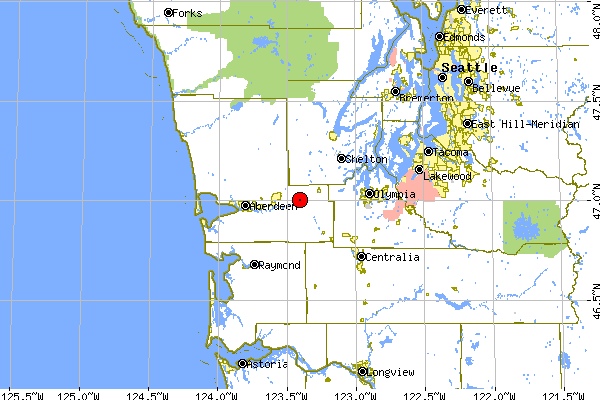
And now about what happened. Here is THE DAILY WORLD article (WA, USA) ( http://www.thedailyworld.com/daily/2003/Jul-15-Tue-2003/news/news1.html ) on the item:
ELMA - Elma High School Senior Brian Reed was bored,
just taking a night drive through Elma's dark, deserted
streets. Closing on 1 a.m., he, his cousin Scott Reed and
fellow Elma Senior Dan Raney hadn't found any more
excitement after midnight than before it.
Then, Reed says, a meteor tore open the night sky.
"We were just driving down the road, and I just saw this big,
bright flash," the 18 - year - old said. "At first, I thought it
was a shooting star or a falling star or something.
"It looked like fireworks, but it had a tail about six or seven -
feet long."
Reed said the falling rock appeared to break apart as it
approached the earth, exploding before impact.
The young men decided to investigate, and headed from the
freeway toward Elma High School, where they believed the
fragments struck.
"We went out there and started looking around, and we saw
a bunch of divot holes in the sand of the track out there,"
Reed said. "We looked for a while, then we went and got a
couple of cops."
Raney, 17, said he tried to pick up a piece of the still - hot
rock and burned his hand.
Soon police joined the young men's investigation, examining
the pock - marked asphalt and dinged ground.
Toby Smith, a University of Washington astronomy lecturer
and meteorite researcher, said Reed's description of events
matches with the stories told by others who have seen falling
meteors.
"It sort of has the hallmarks of being a classic meteorite fall,"
Smith said. "It's actually very rare (to see a meteor strike
the earth), but, as the population density grows, we get more
people reporting seeing this type of thing.
"These types of meteorite fall are reported about once or
twice a year."
After flagging down a Grays Harbor County Sheriff's Deputy,
Reed called his mother and contacted the Elma Police
Department. Working a graveyard shift, Elma Officer Travis
Bealert took the call.
According to Elma Police sources, the officer arrived at the
scene to find the young men searching for pieces of rock.
After examining the site himself, Bealert apparently
continued on his patrol.
Bealert's shift ended early Tuesday and attempts to contact
him were unsuccessful.
Though more than 20,000 tons of material strike the earth's
atmosphere annually, Smith said nearly all of it burns up
before it strikes the ground. Very rarely is material that
actually strikes the earth actually seen.
If the Elma meteorites are extraterrestrial, Smith said he
believes it may be the first meteor strike witnessed in
Washington's history. Six other meteorites have been
recovered in Washington.
Smith said a similar strike was witnessed near a Chicago
suburb last year.
"These things are seen to happen," he said. "Meteorites are
very, very rare things, but a lot of them fall."
The astronomer said meteors passing through the earth's
atmosphere usually burn and deform, leaving a dark, glassy
skin on the rock.
"It really looks like a burnt crust. That's usually a dead
giveaway," Smith said. "If they have the crusts on them,
there's a very good possibility that these could be
meteorites."
Until the rock has been examined, however, Smith said it is
difficult to be certain of its origin.
But, how do three young men of Elma top off their out - of -
this - world night? Snacks, of course.
"We went down to the store behind the bowling alley ... and
got something to eat," Reed said. "We were still pretty
excited."
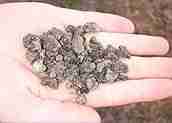
ELMA - There's an out of this world mystery in Grays Harbor County.
Three teenage boys saw a fireball plummeting to Earth early Tuesday morning. Now their meteor, or the story of it, is the biggest thing to hit Elma.
"I looked over and I saw this bright streak through the sky," says Brian Reed. "It had a tail that was probably six or seven feet long and at the end it was glowing red. It was good size."
Brian's cousin Scott Reed also saw it. He says they watched the fireball disappear in the direction of their high school and then saw a cloud of dust go up in the air.
"We came down here and looked," explains Scott, "and all there was, was little holes and craters. We just started digging around right there, moving gravel, and we found little pieces that looked different."
The boys collected handfuls of tiny black rocks. One was so hot, it burned their friend Dan's thumb and finger.
The story of the meteorite crash spread through town, and soon everyone was sifting through the gravel looking for evidence.
"I never would've expected an asteroid or meteor would land in Elma," said one young girl.
And it's starting to look like one didn't.
Meteorite hunters from the Seattle area came to Elma after hearing the story, and they delivered bad news.
"We don't have a sample of it yet," says collector Blake Johnson. "If it stuck to a magnet I'd get pretty excited."
"They might be picking up the wrong rocks," adds collector Adam Hupe. "There might be some real meteorites mixed in there. I don't know. We've got to look at every single one."
The glassy black rocks could be worn asphalt or pieces of the old high school track. Any promising samples will go to scientists at the University of Washington to see if they're genuine.
But even if they're not, imaginations are free to run wild.
"We'll still think that it's awesome," smiles Scott Reed. "We'll still have it in our minds that we started something really big here."
And he adds, "I think it was a meteorite."
KOMO 4 News also received a handful of e-mail from other independent viewers saying they too saw the fireball streak across the sky shortly before 1 a.m.
ELMA - A meteorite is a seductive thing. It draws people towards it, pulls the obsessed to distant corners of the world.
Meteorites have drawn brothers Adam and Greg Hupe from their home in Renton to Africa and Europe. Tuesday they were drawn to Elma to examine the rocks three young men found early Tuesday morning after seeing something they believe to be a meteor heading toward the Elma High School athletic fields.
Unfortunately for Elma residents who've caught meteorite fever, the Hupe brothers had little good news.
"It doesn't look good at this point, but that doesn't mean you won't find something," Adam Hupe told the three young men.
Hupe said he will pass the rocks on to University of Washington professor Tony Irving, a former research scientist with the NASA who often works with the brothers, for further testing. He doesn't, however, hold out much hope that the small, black rocks are of extra - terrestrial origin.
Speaking with the three might - be witnesses, the Hupes said nothing to the young men to cast doubt on what the teens say they saw, only that the rocks they believed to be meteoritic were not.
It was a welcome change for Elma Senior Brian Reed, who said he feels many onlookers believe he and his friends are "full of it." To the critics and cameras, Brian Reed, his cousin Scott Reed and friend Dan Raney could do little but repeat their mantra - "We know what we seen."
While driving on Vance Creek Road just after 12 a.m. Tuesday, the three bored teen - agers saw a fireball with a tail streaking out of the sky followed by a flash. It looked like it was headed toward the Elma track and the young men went for a look.
Once there, they say they examined the apparently pock - marked shotput pit with a tiny, squeezable flashlight. They found glassy black rocks they thought were space rock. Excited, Brian called his mother, then the police for assistance.
Now, it appears those rocks were not out of this world, but the Hupes encouraged the young men and other would - be meteorite hounds to keep searching.
The area where the young men grabbed what they thought were meteorites was swarming with children and adults from all over the Harbor. They sifted through the pea - gravel and combed the grass looking for the extraordinary.
The brothers showed the searchers sample meteorites from other expeditions, hoping to give locals a better picture of their quarry.
It's the same routine they went through last March, when a meteorite came down in Chicago's southside neighborhood.
Hours after hearing about the strike, Adam was on a plane on his way to Chicago. A meteorite had smashed through residents' homes, breaking windows and piercing roofs.
Once on the lookout, locals started bringing in everything from gravel to large chunks of asphalt.
"We went to Chicago and about 90 percent of the rocks people brought to us weren't meteorites," he said.
"But once we showed people what real meteorites look like, they started bringing them in.
"That's what we're here for, to show people what to look for."
Greg Hupe said he and his brother do similar "show - and - tell" demonstrations when they travel to Saharan Africa, training nomadic Bedouin to search for the world's oldest rocks.
Dan Raney said the Hupes impressed him a great deal.
"Those guys are cool," Elma Senior Dan Raney said. "They're just awesome, really laid back."
After spending hours talking about treasure hunting with them, the Hupe brothers gave the three young men small meteorites.
Their cores sparked with elemental iron, the matte black rocks have a strangeness about them. Taking the thumb - size meteorites, the young men carefully pocket them only a little less entranced than when they saw what they saw two nights before.
Hi Mike, Mike and List, The Elma material is definitely not a meteorite, so to speak. It could prove to be just as or more interesting to the scientific community. The jury is still out on exactly what this material is or how it was created. The initial lab results created more questions than answers. As has been reported this material consist of sand incased in a basaltic glass shell. The materials in the glass are not separated into swirls so what ever created these objects had a huge amount of energy and the glass was quenched very rapidly. Experiments are being conducted to see how these might have been created. We should have more answers by next week. This is looking more like an X-files episode than a meteor sighting. For now, we are keeping an open mind regarding this material. All the best, Adam and Greg Hupe